Karl Storz Laparoscopy User manual
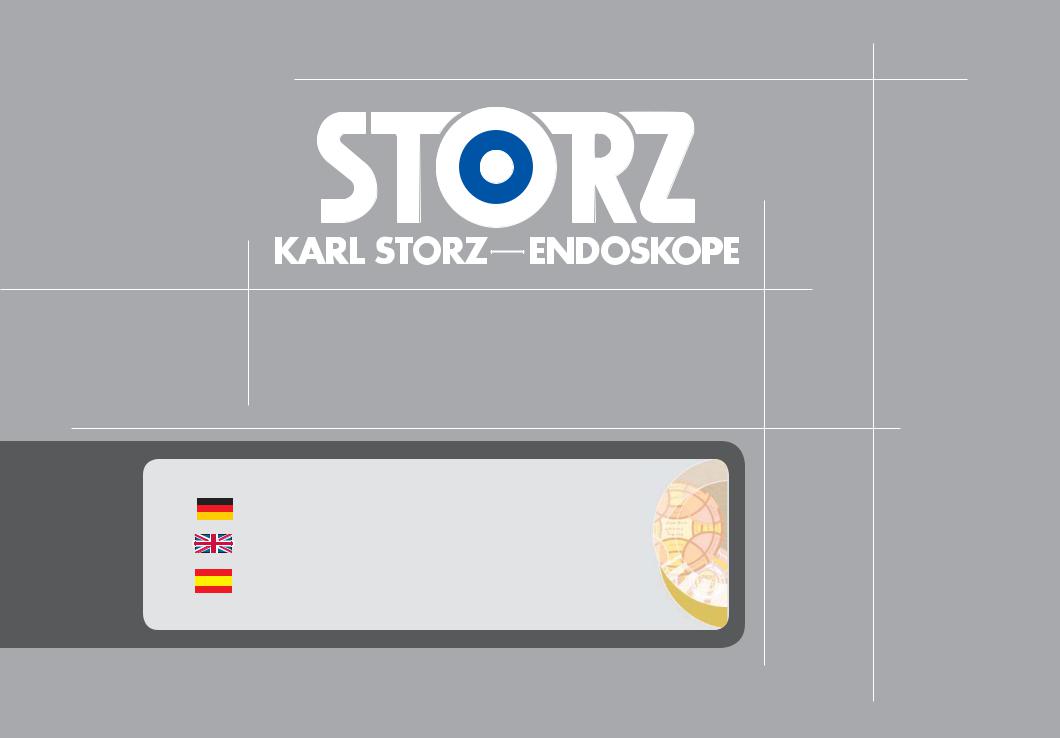
Anleitung LAPAROSKOPIE 1/2007 |
Instructions LAPAROSCOPY 1/2007 |
Instrucción LAPAROSCOPIA 1/2007 |
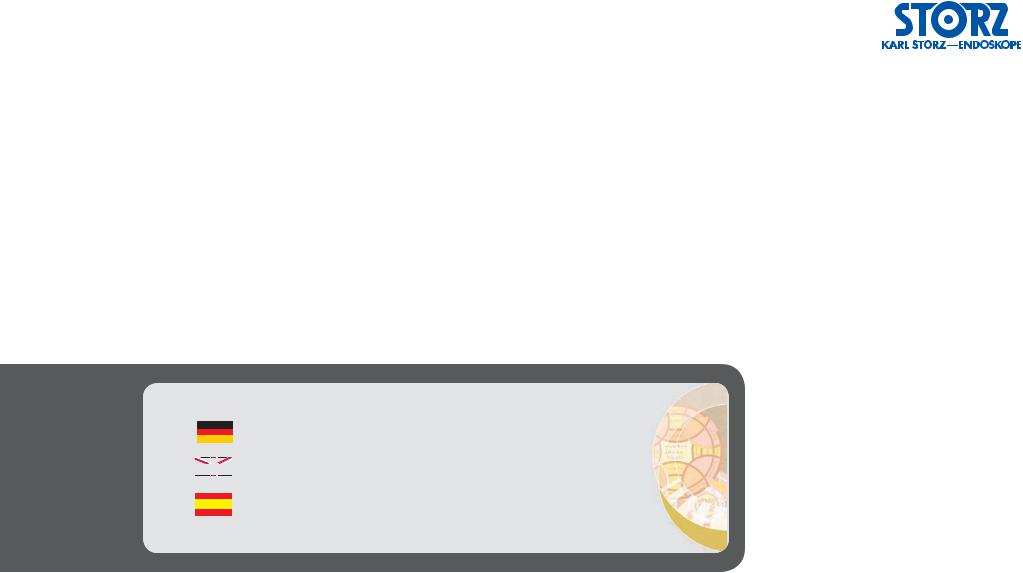
Anleitung
Manual
Manual
Anleitung LAPAROSKOPIE 1/2007


 Instructions LAPAROSCOPY 1/2007
Instructions LAPAROSCOPY 1/2007
Instrucción LAPAROSCOPIA 1/2007
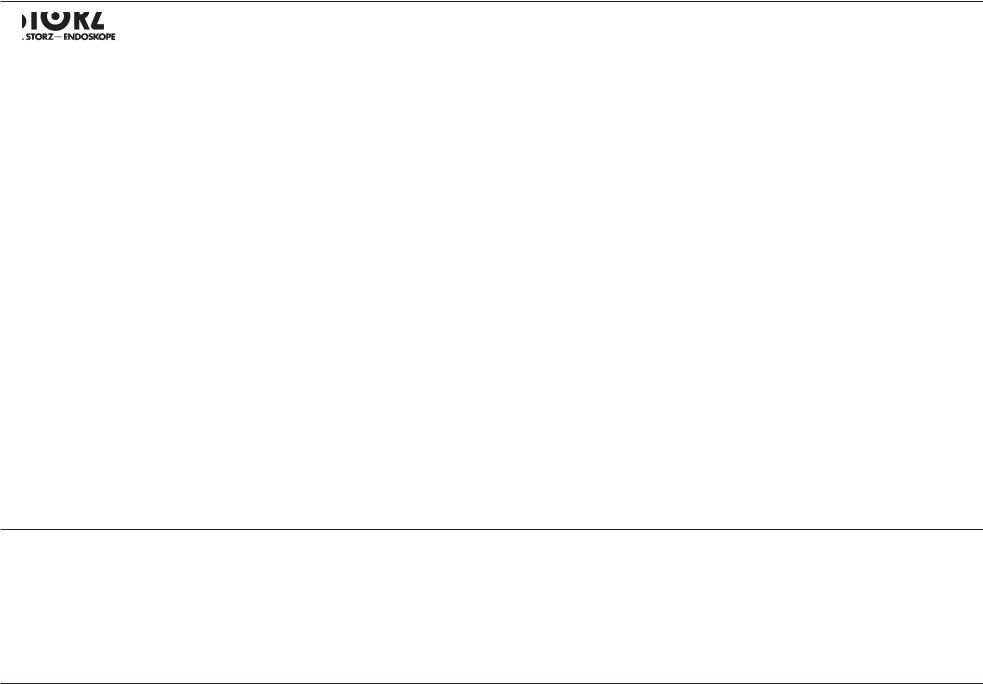
Wichtiger Hinweis für die |
Important information |
Indicaciones importantes |
Benutzer von KARL STORZ |
for users of KARL STORZ |
para usuarios de equipos e |
Geräten und Instrumenten |
instruments |
instrumentos de KARL STORZ |
|
|
|
Vielen Dank für Ihr Vertrauen in den Namen KARL STORZ. Auch in diesen Produkten steckt unsere ganze Erfahrung und Sorgfalt. Sie und Ihr Haus haben sich damit für moderne und hochwertige Instrumente der Firma KARL STORZ entschieden.
Die vorliegende Anleitung dient der Information für das mit der Aufbereitung von Instrumenten für die Laparoskopie beauftragte Personal. Die von KARL STORZ hergestellten Instrumente sind in der Regel empfi ndliche Präzisionsinstrumente, die eine besondere Sorgfalt bei der Aufbereitung verlangen. Um Schäden bei der Aufbereitung
zu vermeiden, wird hier eine Hilfestellung zur Demontage, Aufbereitung und Montage des endoskopischen Instrumentariums von KARL STORZ gegeben.
Thank you for your expression of confi dence in the KARL STORZ brand name. Like all of our other products, these products are the result of years of experience and great care in manufacture. You and your organization have decided in favor of modern, high-quality items of equipment from KARL STORZ.
This manual contains information for personnel authorized to prepare instruments for laparoscopy. The instruments and accessories manufactured by KARL STORZ are, as a rule, sensitive precision instruments which require particular care during preparation. To prevent damage during preparation, support is provided here for disassembly, preparation and assembly of the KARL STORZ endoscopic instruments.
Agradecemos la confi anza que han depositado en la marca KARL STORZ. Este productos, como
todos los demás, es el resultado de nuestra amplia experiencia y esmero. Por ello, al decidirse por KARL STORZ se han decidido, tanto Ud. como su empresa, por productos de precisión moderno y de alta calidad.
La presente Instrucción tiene por objeto informar al personal encargado de la preparación de instrumentos laparoscopicos. Los instrumentos y accesorios fabricados por KARL STORZ son generalmente instrumentos de precisión, que requieren un esmero especial en su preparación. Con el fi n de evitar deterioros durante la preparación, esta instrucción proporciona una ayuda para el desmontaje, preparación y montaje de los instrumentos de KARL STORZ.
2008-12 – 4.3 Version
KARL STORZ arbeitet ständig an der Weiterentwicklung aller Produkte. Bitte haben Sie Verständnis dafür, dass deshalb Änderungen des Lieferumfangs, der Form, Ausstattung und Technik möglich sind. Aus den Angaben, Abbildungen und Beschreibungen dieser Anleitung können daher keine Ansprüche hergeleitet werden.
KARL STORZ is constantly working on the further development of all products. Please appreciate that changes to the scope of supply in form, equipment and technology are possible for this reason. Therefore, no claims may be deduced from the information, fi gures and descriptions in this manual.
KARL STORZ trabaja continuamente en el desarrollo de todos sus productos. Por este motivo rogamos comprendan que pueden producirse modifi caciones en el suministro, tanto en cuanto a forma como a equipamiento y técnica. De las indicaciones, ilustraciones y descripciones no emana por ello derecho alguno.
U 2
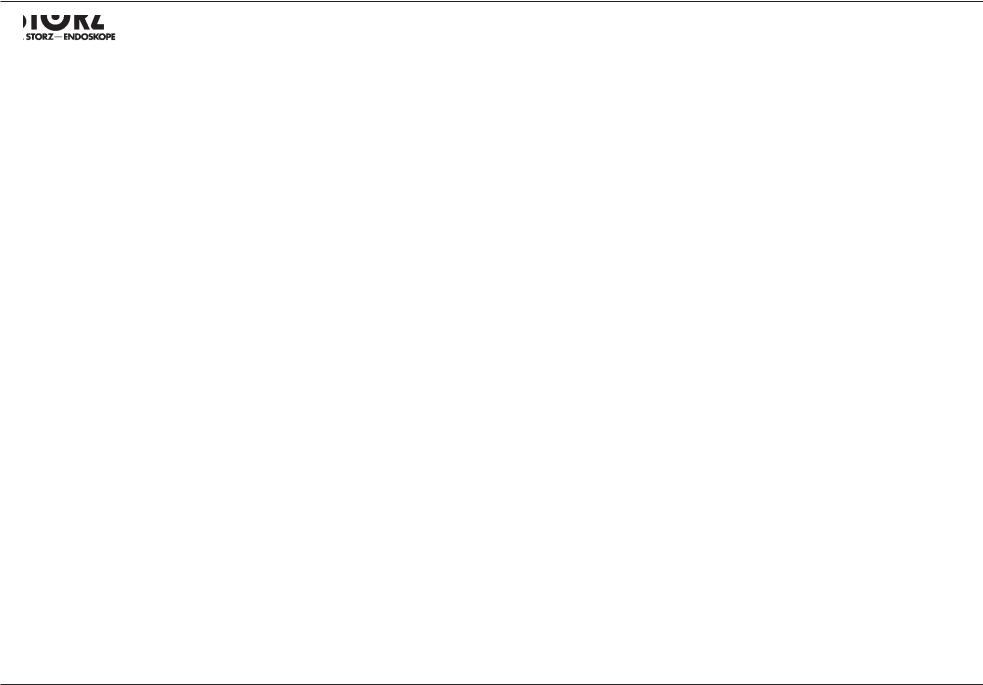
Inhalt |
Contents |
Contenido |
|
|
|
|
|
|
WICHTIGER HINWEIS FÜR DIE |
IMPORTANT INFORMATION FOR USERS |
INDICACIONES IMPORTANTES PARA |
|
BENUTZER VON KARL STORZ |
OF KARL STORZ UNITS AND |
|
USUARIOS DE EQUIPOS E |
GERÄTEN UND INSTRUMENTEN........ |
U 2 INSTRUMENTS ..................................... |
U 2 |
INSTRUMENTOS DE KARL STORZ ...U 2 |
ÜBER DIESE ANLEITUNG....................... |
5 |
Handhabung dieser Anleitung............................ |
5 |
Symbole und Gefahrenhinweise......................... |
6 |
Sicherheitshinweise............................................ |
7 |
Generelle Hinweise zur Reinigung |
|
und Sterilisation.................................................. |
9 |
ABOUT THIS MANUAL ............................ |
5 |
Using this manual............................................... |
5 |
Symbols and hazard information........................ |
6 |
Safety information .............................................. |
7 |
General information on cleaning and |
|
sterilization ......................................................... |
9 |
TROKARE FÜR DIE LAPAROSKOPIE .. |
16 |
TROCARS FOR LAPAROSCOPY .......... |
16 |
|
Konen für offene Laparoskopie ........................ |
16 |
Cones for open laparoscopy ............................ |
16 |
|
Allgemeine Hinweise für Trokare und Zubehör. 16 |
General information for trocars and |
|
||
Pneumoperitoneum-Kanüle n. VERESS........... |
17 |
accessories ...................................................... |
16 |
|
Starre Trokare mit Silikonlippen- |
|
VERESS pneumoperitoneum cannulas ............ |
17 |
|
ventil, 2,5/11 mm.............................................. |
18 |
Rigid trocars with silicone lip valve, |
|
|
Flexible Trokare mit Silikonlippenventil 9 mm .. |
18 |
2.5/11 mm ........................................................ |
18 |
|
Trokare mit Multifunktionsventil ....................... |
20 |
Flexible trocars with silicone lip valve 9 mm .... |
18 |
|
Trokare mit automatischem |
|
Trocars with multifunction valve ...................... |
20 |
|
Klappenventil < 5 mm ...................................... |
23 |
Trocars with automatic ap valve < 5 mm........ |
23 |
|
Trokare mit automatischem |
|
Trocars with automatic ap valve 6 - 13 mm .. |
24 |
|
Klappenventil 6 -13 mm ................................... |
24 |
Instructions for LUER LOCK stopcocks........... |
25 |
|
Anweisung für LUER LOCK Hähne .................. |
25 |
Reduction cannulas / Extractors ...................... |
27 |
|
Reduzierstücke / Extraktoren ........................... |
27 |
Spiral cannulas................................................. |
27 |
|
Spiralhülsen...................................................... |
27 |
Distance holders............................................... |
28 |
|
Distanzhalter..................................................... |
28 |
Dilation set........................................................ |
29 |
|
Dilatations-Set ................................................. |
29 |
Preparation overview........................................ |
30 |
|
Überblick Aufbereitung..................................... |
30 |
DISSECTING AND GRASPING |
|
|
|
|
|
||
PRÄPARIERUND FASSZANGEN ........ |
31 |
FORCEPS ............................................... |
31 |
|
Allgemeine Hinweise für |
|
General information for forceps and scissors .. |
31 |
|
|
cinstruments with and without |
|
||
Zangen und Scheren ........................................ |
31 |
32 |
||
cInstrumente mit und |
|
connector pin for unipolar coagulation ............ |
||
|
cgrasping forceps, angulating |
35 |
||
ohne Anschluss für unipolare Koagulation....... |
32 |
|||
cAbwinkelbare Fasszange |
35 |
Take-apart instruments with |
|
|
U-spring handle |
37 |
|||
Zerlegbare Instrumente mit |
|
|||
U-Feder-Handgriff |
37 |
Insulated instruments with |
|
|
U-spring handle |
39 |
|||
Isolierte Instrumente mit |
|
|||
|
Surgical sponge holder |
40 |
||
U-Feder-Handgriff |
39 |
|||
General information on coagulation |
|
|||
Präparier-Tupferhalter....................................... |
40 |
|
||
Allgemeine Hinweise für |
|
instruments....................................................... |
43 |
|
Koagulationsinstrumente.................................. |
43 |
Take-apart® forceps with double sheath for |
|
|
Take-apart® Zangen mit Doppelschaft für |
|
bipolar coagulation........................................... |
45 |
|
die Bipolar-Koagulation.................................... |
45 |
RoBi™ instruments .......................................... |
48 |
|
RoBi™ Instrumente .......................................... |
48 |
Preparation overview........................................ |
51 |
|
Überblick Aufbereitung..................................... |
51 |
SCISSORS, PUNCHES AND |
|
|
SCHEREN, STANZEN UND ZANGEN |
52 |
|
||
FORCEPS ............................................... |
52 |
|||
Mikro-Guillotine n. KOH ................................... |
52 |
KOH micro guillotine ........................................ |
52 |
|
Überblick Aufbereitung..................................... |
53 |
Preparation overview........................................ |
53 |
|
ACERCA DE ESTA INSTRUCCIÓN......... |
5 |
Manejo de esta instrucción ................................ |
5 .. |
Símbolos e indicaciones de peligro ................... |
6 |
Instrucciones de seguridad ................................ |
7 |
Indicaciones generales en cuanto a limpieza |
|
y esterilización.................................................... |
9 |
TROCARES PARA LAPAROSCOPIA..... |
16 |
Conos para laparoscopia abierta ..................... |
16 |
Instrucciones generales para trocares y |
|
accesorios ........................................................ |
16 |
Cánulas para neumoperitoneo seg. VERESS . 17 |
|
Trocares rígidos con válvula con labio de |
|
silicona de 2,5/11 mm ...................................... |
18 |
Trocares exibles con válvula con labio de |
|
silicona de 9 mm .............................................. |
18 |
Trocares con válvula multifuncional ............... |
20 |
Trocares con válvula de mariposa < 5 mm....... |
23 |
Trocares con válvula de mariposa 6 - 13 mm . 24 |
|
Instrucciones para llaves con cierre LUER ...... |
25 |
Cánulas de reducción / extractores ................. |
27 |
Cánulas en espiral............................................ |
27 |
Distanciadores.................................................. |
28 |
Set de dilatación............................................... |
29 |
Vista general - Preparación .............................. |
30 |
PINZAS DE PREPARACIÓN Y |
|
AGARRE ................................................. |
31 |
Instrucciones generales para pinzas y tijeras.... |
31 |
Instrumentos ccon y sin conexión |
|
para coagulación monopolar............................ |
32 |
Pinzas de agarre c, angulables ............ |
35 |
Instrumentos desmontables con mango de |
|
resorte en U...................................................... |
37 |
Instrumentos con aislamiento con mango de |
|
resorte en U...................................................... |
39 |
Portatorundas de preparación ......................... |
40 |
Instrucciones generales para coagulación....... |
43 |
Pinzas Take-apart® con vaina doble |
|
para la coagulación bipolar .............................. |
45 |
Instrumentos RoBi™ ........................................ |
48 |
Vista general - Preparación .............................. |
51 |
TIJERAS, PUNZONES Y PINZAS ......... |
52 |
Guillotina en miniatura seg. KOH ..................... |
52 |
Vista general - Preparación .............................. |
53 |
1
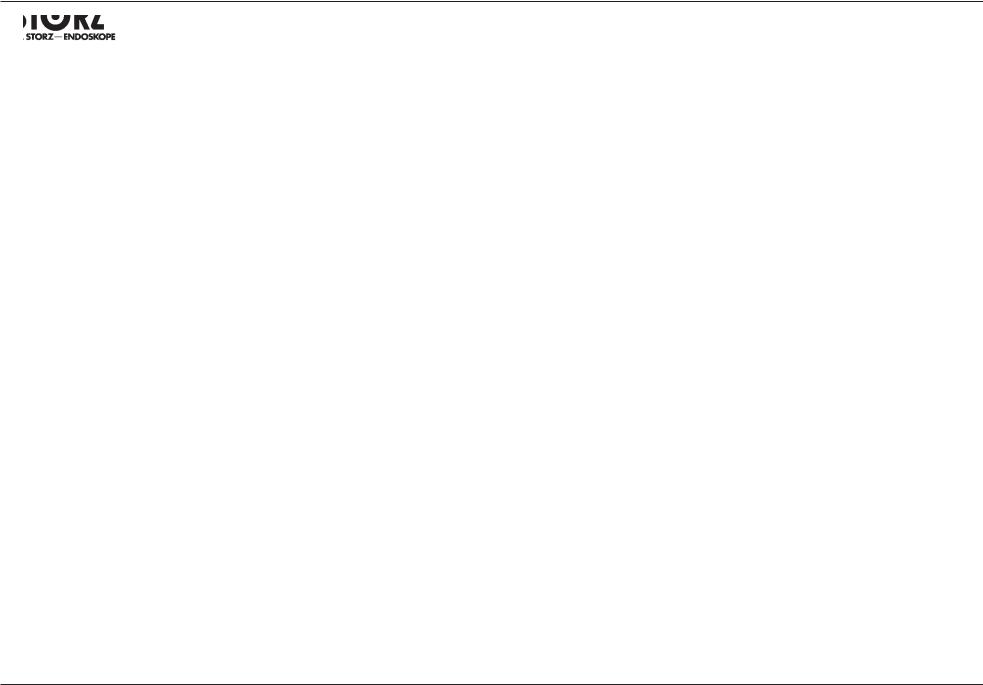
Inhalt |
Contents |
Contenido |
|
|
|
|
|
|
INSTRUMENTE FÜR DIE UNIPOLARE |
|
INSTRUMENTS FOR UNIPOLAR, |
|
INSTRUMENTOS PARA LA COAGU- |
|
|
UND BIPOLARE KOAGULATION.......... |
55 |
AND BIPOLAR COAGULATION ............ |
55 |
LACIÓN MONO Y BIPOLAR ................. |
55 |
|
Allgemeine Hinweise für |
|
General information on |
|
Instrucciones generales para intrumentos |
|
|
Koagulationsinstrumente.................................. |
55 |
coagulation instruments................................... |
55 |
para coagulación.............................................. |
55 |
|
Dissektions-Elektroden mit austauschbarer |
|
Dissecting electrodes with exchangeable tip... |
57 |
Electrodos de disección con punta |
|
|
Spitze ............................................................... |
57 |
MANHES high-frequency needle ..................... |
59 |
intercambiable.................................................. |
57 |
|
Hochfrequenznadel n. MANHES ...................... |
59 |
Coagulation and dissecting electrodes............ |
60 |
Aguja de alta frecuencia seg. MANHES........... |
59 |
|
Koagulationsund Dissektionselektroden........ |
60 |
Bipolar needle .................................................. |
61 |
Electrodos para corte y coagulación................ |
60 |
|
Bipolare Nadel.................................................. |
61 |
Take-apart® bipolar coagulation suction tube .. |
62 |
Aguja bipolar .................................................... |
61 |
|
Take-apart® Bipolar-Koagulations-Saugrohr .... |
62 |
GORDTS-CAMPO coagulation suction tube ... |
63 |
Tubo Take-apart® para succión y coagulación |
|
|
Koagulations-Saugrohr n. GORDTS-CAMPO .. |
63 |
Adaptor for coagulation and dissecting |
|
bipolar .............................................................. |
62 |
|
Adapter für Koagulationsund Dissektionselek- |
electrodes......................................................... |
64 |
Tubo para succión y coagulación seg. |
|
||
troden ............................................................... |
64 |
REMORGIDA bipolar instrument...................... |
65 |
GORDTS-CAMPO ............................................ |
63 |
|
Bipolar-Instrument n. REMORGIDA ................. |
65 |
Preparation overview........................................ |
69 |
Adaptador p/electrodos de corte y coagul. ..... |
64 |
|
Überblick Aufbereitung..................................... |
69 |
|
|
Instrumento bipolar seg. REMORGIDA............ |
65 |
|
RETRAKTOREN, DISSEKTOREN, TAST- |
RETRACTORS, DISSECTORS, PALPA- |
|
Vista general - Preparación .............................. |
69 |
||
TION PROBES AND EXTRACTORS ..... |
70 |
RETRACTORES, DISECTORES, |
|
|||
STÄBE UND EXTRAKTOREN |
70 |
CUSCHIERI liver retractor |
70 |
|
||
PALPADORES Y EXTRACTORES |
70 |
|||||
Leber-Retraktor n. CUSCHIERI ........................ |
70 |
Take-apart fan retractor, 5 mm and 10 mm...... |
72 |
|||
Zerlegbarer Fächer-Retraktor, |
|
De ecting retractor model 26173 FP................ |
73 |
Retractor del hígado seg. CUSCHIERI............. |
70 |
|
5 mm und 10 mm ............................................. |
72 |
Retractors for gastric banding.......................... |
74 |
Retractor en abanico desmontable, 5 mm y |
|
|
Spreizbarer Retraktor Modell 26173 FP ........... |
73 |
Anal dilators...................................................... |
75 |
10 mm ............................................................. |
72 |
|
Retraktoren für Gastric Banding....................... |
74 |
Take-apart CUSCHIERI variable curvature |
|
Retractor expandible, modelo 26173 FP ......... |
73 |
|
Anal-Dilatatoren................................................ |
75 |
dissector .......................................................... |
76 |
Retractores para banda gástrica...................... |
74 |
|
Zerlegbarer Dissektionspatel mit |
|
Preparation overview........................................ |
77 |
Dilatadores anales............................................ |
75 |
|
variabler Krümmung n. CUSCHIERI ................ |
76 |
|
|
Espátula de disección desmontable con |
|
|
Überblick Aufbereitung..................................... |
77 |
SUTURE AND LIGATURE ...................... |
78 |
curvatura variable seg. CUSCHIERI ................ |
76 |
|
|
|
Needle holder and suture instrument |
|
Vista general - Preparación .............................. |
77 |
|
.............................NAHT UND LIGATUR |
78 |
with ring handle ................................................ |
78 |
SUTURA Y LIGADURA |
78 |
|
Nadelhalter und Nahtinstrument |
|
Needle holder with straight and curved handle, |
||||
mit Ringhandgriff .............................................. |
78 |
with and without ratchet................................... |
78 |
Portaagujas e instrumento de sutura con |
|
|
Nadelhalter mit geradem und gebogenem |
|
SCARFI needle holder ...................................... |
79 |
mango de anilla ................................................ |
78 |
|
Handgriff, mit oder ohne Raste ........................ |
78 |
DUBECQ/PRINCETEAU needle holder ............ |
80 |
Portaagujas con mango recto y curvado, |
|
|
Nadelhalter n. SCARFI ..................................... |
79 |
CUSCHIERI integrated knot pusher and |
|
con y sin bloqueo ............................................. |
78 |
|
Abwinkelbarer Nadelhalter |
|
thread catcher .................................................. |
82 |
Portaagujas seg. SCARFI................................. |
79 |
|
n. DUBECQ/PRINCETEAU............................... |
80 |
Take-apart CUSCHIERI variable curvature |
|
Portaagujas acodable seg. |
|
|
Integrierter Knotenschieber mit Fadenfänger |
|
suture and sling passer .................................... |
83 |
DUBECQ/PRINCETEAU................................... |
80 |
|
n. CUSCHIERI .................................................. |
82 |
Clip applicator model 30444 LR....................... |
85 |
Anudador integrados con captahilos seg. |
|
|
Zerlegbarer Fadenund Schlingenführer mit |
|
Preparation overview........................................ |
87 |
CUSCHIERI ...................................................... |
82 |
|
variabler Krümmung n. CUSCHIERI................. |
83 |
MODULAR HANDLES AND INSTRU- |
|
Guía desmontable para hilos y lazos con |
|
|
Clip-Applikator Modell 30444 LR ..................... |
85 |
|
curvatura variable seg. CUSCHIERI................. |
83 |
||
Überblick Aufbereitung..................................... |
87 |
MENTS FOR SUCTION AND |
|
Aplicador de clips modelo 30444 LR ............... |
85 |
|
|
|
IRRIGATION |
88 |
Vista general - Preparación .............................. |
87 |
|
|
|
|
|
|||
|
|
Handle with piston valve .................................. |
88 |
|
|
Handle 30810 for irrigation, suction and |
|
|
|
coagulation....................................................... |
89 |
Handgriff mit Kolbenventil................................ |
88 |
Handle for irrigation and suction |
|
Handgriff 30810 für Spülung, |
|
models 37112 T, 37113 T ................................ |
92 |
Absaugung und Koagulation............................ |
89 |
Metal suction and irrigation tubes.................... |
95 |
Handgriff für Spülung und Absaugung |
|
Suction and irrigation tubes with two-way |
|
Modelle 37112 T 37113 T................................. |
92 |
stopcock........................................................... |
95 |
Saugund Spülrohre aus Metall....................... |
95 |
Preparation overview........................................ |
96 |
Saugund Spülrohre mit Zweiwegehahn......... |
95 |
|
|
Überblick Aufbereitung..................................... |
96 |
|
|
MANGOS MODULARES E INSTRUMENTOS |
|
PARA IRRIGACIÓN Y SUCCIÓN........... |
88 |
Mango con válvula de vástago......................... |
88 |
Manipulador 30810 para irrigación, succión |
|
y coagulación ................................................... |
89 |
Manipulador para irrigación y succión |
|
modelos 37112 T, 37113 T............................... |
92 |
Tubos de metal para irrigación y succión......... |
95 |
Tubos p/irrig. y succión c/llave de dos vías ..... |
95 |
Vista general - Preparación .............................. |
96 |
2
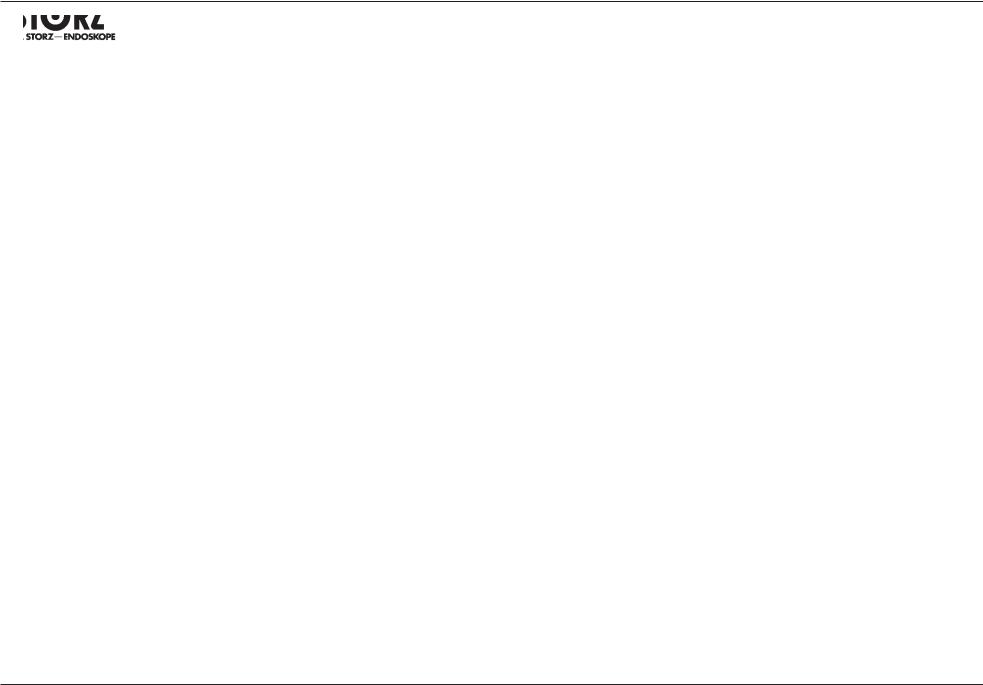
Inhalt |
Contents |
Contenido |
|
|
|
|
|
|
INSTRUMENTE FÜR DIE |
|
INSTRUMENTS FOR |
|
|
LASER-CHIRURGIE............................... |
97 |
LASER SURGERY .................................. |
97 |
|
Schäfte für CO2-LASER.................................... |
97 |
Sheaths for CO2 LASERS................................. |
97 |
|
CO2-Laser Coupler ........................................... |
97 |
CO2 laser coupler ............................................. |
97 |
|
Adapter für CO2-Laser Coupler ........................ |
97 |
Adapter for CO2 laser coupler .......................... |
97 |
|
Überblick Aufbereitung..................................... |
98 |
Preparation overview........................................ |
98 |
|
INGUINAL-KANAL-RETRAKTOR, IN- |
|
INGUINAL CANAL RETRACTOR, |
|
|
STRUMENTE FÜR DIE MINILAPAROTO- |
|
|||
INSTRUMENTS FOR MINI-LAPAROTO- |
||||
MIE UND FÜR DIE HANDASSISTIERTE |
||||
MY AND FOR HAND-ASSISTED |
|
|||
LAPAROSKOPISCHE CHIRURGIE |
98 |
|
||
LAPAROSCOPIC SURGERY ................. |
98 |
|||
DUNDEE Multitool............................................ |
98 |
DUNDEE multitool |
98 |
|
Inguinal-Kanal-Retraktor n. CUSCHIERI |
98 |
|||
CUSCHIERI inguinal canal retractor |
98 |
|||
Instrumente für die handassistierte |
|
|||
|
Instruments for hand-assisted laparoscopic |
|
||
laparoskopische Chirurgie |
98 |
|
||
surgery |
98 |
|||
Überblick Aufbereitung |
100 |
|||
Preparation overview |
100 |
|||
|
|
|||
MORCELLATOREN.............................. |
101 |
MORCELLATORS |
101 |
|
Morcellator n. STEINER.................................. |
101 |
|||
Morcellator n. SAWAHLE ............................... |
106 |
STEINER morcellator...................................... |
101 |
|
Morcellations-Messer n. CHARDONNENS .... |
113 |
SAWAHLE morcellator.................................... |
106 |
|
KARL STORZ ROTOCUT G1.......................... |
115 |
CHARDONNENS morcellation knife............... |
113 |
|
Überblick Aufbereitung................................... |
116 |
KARL STORZ ROTOCUT G1.......................... |
115 |
|
|
|
Preparation overview...................................... |
116 |
|
INTRAOPERATIVE CHOLANGIOGRA- |
|
INTRAOPERATIVE CHOLANGIOGRAPHY |
||
PHIE UND CHOLEDOCHOSKOPIE,... 119 |
||||
Cholangiographie-Fixierzange n. OLSEN....... |
119 |
AND CHOLEDOCHOSCOPY .............. |
119 |
|
cFasszange nach BERCI, |
|
OLSEN cholangiography xation forceps ...... |
119 |
|
mit gummibeschichteten Maulteilen .............. |
119 |
BERCI cgrasping forceps, |
|
|
Mikro-Messer ................................................. |
120 |
with rubber-coated jaws................................. |
119 |
|
Endotom......................................................... |
122 |
Micro scissors ................................................ |
120 |
|
Überblick Aufbereitung................................... |
123 |
Endotom......................................................... |
122 |
|
ANAL-CHIRURGIE |
124 |
Preparation overview...................................... |
123 |
|
ANAL SURGERY |
124 |
|||
Video-Operations-Rektoskop......................... |
124 |
|||
Überblick Aufbereitung................................... |
126 |
Video operating rectoscope ........................... |
124 |
|
LAPAROSKOPISCHE AORTENCHIRUR- |
Preparation overview...................................... |
126 |
||
|
|
|||
GIE, INSTRUMENTE FÜR DIE HAND- |
|
LAPAROSCOPIC AORTIC SURGERY, |
|
|
ASSISTIERTE LAPAROSKOPISCHE |
|
INSTRUMENTS FOR HAND-ASSISTED |
||
CHIRURGIE .......................................... |
127 |
LAPAROSCOPIC SURGERY................ |
127 |
|
Trokare |
|
Trocars |
|
|
siehe Trokare für die Laparoskopie |
|
See Trocars for laparoscopy |
|
|
cScheren und Zangen |
|
cscissors and forceps |
|
|
siehe Präparierund Fasszangen |
|
See Dissecting and frasping forceps |
|
|
Instrumente für die handassistierte laparoskopi- |
Instruments for hand-assisted laparoscopic |
|
||
sche Chirurgie |
|
surgery |
|
|
siehe Inguinalretraktor, Instrumente für die Mini- |
See Inguinal retractor, instruments for |
|
||
laparoskopie |
|
mini-laparoscopy |
|
|
INSTRUMENTOS PARA LA |
|
CIRUGIA LÁSER .................................... |
97 |
Vainas para LÁSER DE CO2 ............................ |
97 |
Acoplador para láser de CO2............................ |
97 |
Adaptador para acoplador de láser de CO2 ..... |
97 |
Vista general - Preparación ............................ |
100 |
RETRACTOR PARA EL CANAL INGUINAL, |
|
INSTRUMENTOS PARA MINILAPAROTO- |
|
MÍA Y CIRUGÍA LAPAROSCÓPICA |
|
ASISTIDA MANUALMENTE,.................. 98 |
|
Instrumento múltiple DUNDEE......................... |
98 |
Retractor del canal inguinal seg. CUSCHIERI |
.. 98 |
Instrumentos para la cirugía laparoscópica |
|
asistida manualmente ...................................... |
98 |
Vista general - Preparación ............................ |
100 |
MORCELADORES................................ |
101 |
Morcelador según STEINER........................... |
101 |
Morcelador según SAWAHLE ........................ |
106 |
Bisturí para morcelación seg. |
|
CHARDONNENS ............................................ |
113 |
ROTOCUT G1 de KARL STORZ..................... |
115 |
Vista general - Preparación ............................ |
100 |
COLANGIOGRAFIA INTRAOPERATIVA |
|
Y COLEDOCOSCOPIA, ....................... 119 |
|
Pinzas de jación para colangiografía seg. |
|
OLSEN............................................................ |
119 |
Pinzas de agarre cseg. BERCI, |
|
con mordazas con revestimiento de goma .... |
119 |
Bisturí en miniatura......................................... |
120 |
Endotomo....................................................... |
122 |
Vista general - Preparación ............................ |
123 |
CIRUGÍA ANAL..................................... |
124 |
Rectoscopio quirúrgico para vídeo ................ |
124 |
Vista general - Preparación ............................ |
126 |
CIRUGÍA AÓRTICA LAPAROSCÓPICA, |
|
INSTRUMENTOS PARA LA CIRUGÍA |
|
LAPAROSCÓPICA ASISTIDA |
|
MANUALMENTE .................................. |
127 |
Trocares |
|
véase Trocares para laparoscopia |
|
Pinzas y tijeras c |
|
véase Pinzas de preparación y agarre |
|
Instrumentos para la cirugía laparoscópica asistida |
|
manualmente |
|
véase Retractor para el canal inguinal, instrumen- |
|
tos para la minilaparotomía |
|
3
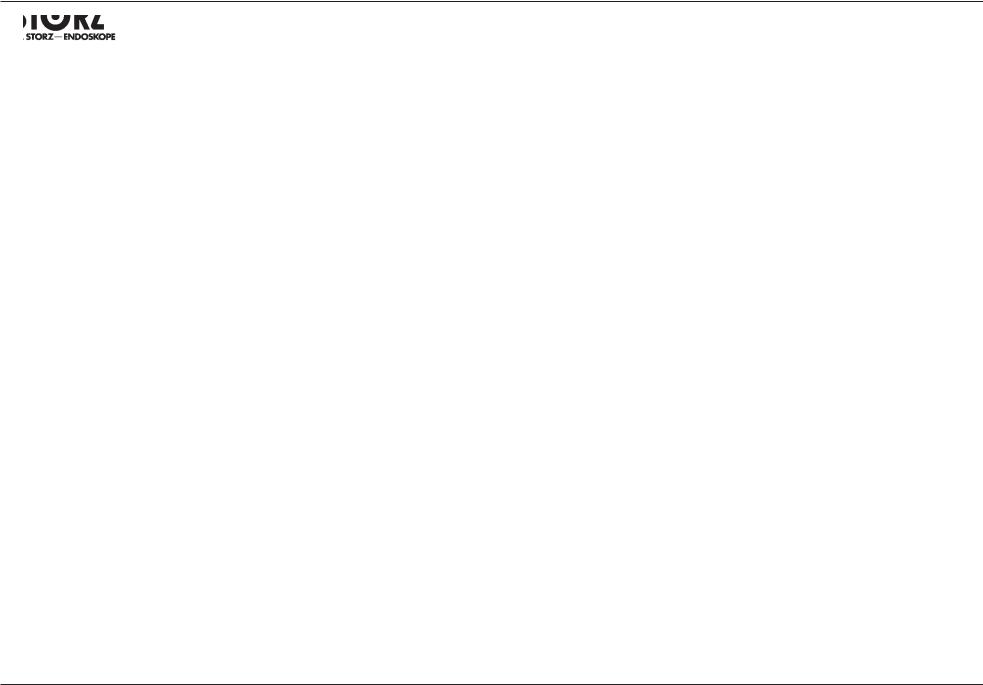
Inhalt |
Contents |
Contenido |
|
|
|
|
|
|
INSTRUMENTE FÜR DIE VIDEOGE- |
|
INSTRUMENTS FOR VIDEO-ASSISTED |
||
STÜTZTE SCHILDDRÜSENENT- |
|
THYROIDECTOMY............................... |
128 |
|
FERNUNG............................................. |
128 |
Dissecting and grasping forceps |
|
|
Präparierund Fasszangen |
|
See Dissecting and grasping forceps |
|
|
siehe Präparierund Fasszangen |
|
Bipolar coagulation forceps |
|
|
Bipolare Koagulationszange |
|
See Instruments for unipolar and bipolar |
|
|
|
coagulation |
|
||
siehe Instrumente für die unipolare und bipolare |
|
|||
Koagulation |
|
GYNECOLOGY |
129 |
|
|
|
|||
GYNÄKOLOGIE.................................... |
129 |
Intrauterine probes and uterus elevators ....... |
129 |
|
Intrauterin-Sonden und Uterus-Elevatoren |
129 |
COHEN intrauterine probe ............................. |
129 |
|
Tenaculum forceps / Uterus grasping forceps130 |
||||
Intrauterin-Sonde n. COHEN |
129 |
|||
SWOLIN cervix cannula |
131 |
|||
Tenaculum-Zange/Uterus-Fasszange |
130 |
|||
HOHL uterine manipulator |
132 |
|||
Cervix-Kanüle n. SWOLIN |
131 |
|||
CLERMONT-FERRAND model uterine |
|
|||
Uterus-Manipulator n. HOHL |
132 |
|
||
manipulator |
135 |
|||
Uterus-Manipulator |
|
|||
n. CLERMONT-FERRAND |
135 |
.......................SAWAHLE uterine manipulator |
142 |
|
C.C.L. vaginal extractor |
146 |
|||
Uterus-Manipulator n. SAWAHLE |
142 |
|||
Ovarian biopsy forceps |
147 |
|||
C.C.L.-Vaginal-Extraktoren |
146 |
|||
Ring applicator for 2/4 rings |
|
|||
Ovarial-Biopsie-Zange 26173 PN |
147 |
|
||
26173 RA/26174 RA |
148 |
|||
Ringapplikator für 2/4 Ringe |
|
|||
26173 RA/26174 RA |
148 |
.............REMORGIDA double bipolar forceps |
151 |
|
GYNFORCE III Take-apart punch |
154 |
|||
Bipolare Fasszange n. REMORGIDA |
151 |
|||
Preparation overview |
161 |
|||
GYNFORCE III Take-apart-Stanze ................. |
154 |
|||
Überblick Aufbereitung................................... |
161 |
|
|
|
INSTANDHALTUNG.............................. |
162 |
Betriebs-/Lagerbedingungen ........................ |
162 |
Entsorgung .................................................... |
162 |
Richtlinienkonformität.................................... |
162 |
Verantwortlichkeit.......................................... |
162 |
Garantie......................................................... |
163 |
Wichtige Information ..................................... |
163 |
Instandsetzung.............................................. |
164 |
Reparatur-Austauschprogramm.................... |
164 |
ANHANG ............................................... |
165 |
Reinigungs-und Desinfektionsmittel.............. |
165 |
MAINTENANCE.................................... |
162 |
Operating/Storage conditions ........................ |
162 |
Disposal.......................................................... |
162 |
Directive compliance...................................... |
162 |
Limitation of liability........................................ |
162 |
Warranty ......................................................... |
163 |
Important information..................................... |
163 |
Servicing and repair........................................ |
164 |
Repair and replacement program................... |
164 |
APPENDIX ............................................ |
165 |
Cleaning agents and disinfectants ................. |
165 |
INSTRUMENTOS PARA LA
TIROIDECTOMÍA ASISTIDA POR VÍDEO128
Pinzas de preparación y agarre véase Pinzas de preparación y agarre
Pinzas bipolares para coagulación
véase Instrumentos para la coagulación mono y bipolar
GINECOLOGÍA ..................................... |
129 |
Sondas intrauterinas y elevadores de útero .. |
129 |
Sonda intrauterina seg. COHEN..................... |
129 |
Tenáculo/pinzas para sujeción del útero ........ |
130 |
Cánula cervical seg. SWOLIN ........................ |
131 |
Manipulador uterino seg. HOHL..................... |
132 |
Manipulador uterino según |
|
CLERMONT-FERRAND ................................. |
135 |
Manipulador uterino según SAWAHLE........... |
142 |
Extractor vaginal C.C.L. ................................. |
146 |
Pinza para biopsia de ovarios 26173 PN ....... |
147 |
Aplicador de anillos para 2/4 anillos |
|
26173 RA/26174 RA....................................... |
148 |
Pinza de agarre bipolar seg. REMORGIDA .... |
151 |
Punzón Take-apart GYNFORCE III ................... |
154 |
Vista general - Preparación ............................ |
161 |
MANTENIMIENTO................................ |
162 |
Condiciones de servicio/almacenamiento .... |
162 |
Gestión de desecho ...................................... |
162 |
Conformidad con las directivas..................... |
162 |
Responsabilidad............................................ |
162 |
Garantía......................................................... |
163 |
Observaciones importantes .......................... |
163 |
Reparaciones ................................................ |
164 |
Programa de reparación e intercambio......... |
164 |
ANEXO .................................................. |
165 |
Productos de limpieza y desinfección............... |
165 |
4
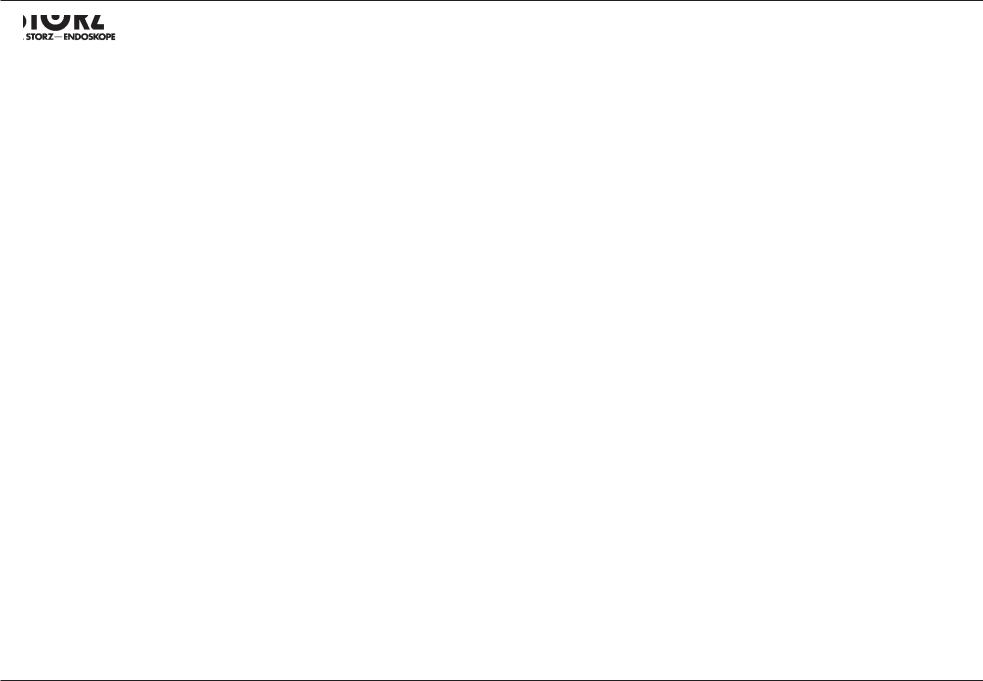
Über diese Anleitung |
About this manual |
Acerca de esta Instrucción |
|
|
|
|
|
|
Handhabung dieser Anleitung
Diese Anleitung ist keine Gebrauchsanweisung, sondern gibt Hinweise zur Demontage, Aufbereitung und Montage des Instrumentariums für den Fachbereich Laparoskopie. Diese Anleitung setzt die Kenntnis der Anleitung „Reinigung, Sterilisation und P ege von KARL STORZ Instrumenten“ voraus, in der die verschiedenen Aufbereitungsverfahren detailliert beschrieben sind. Sollten Sie über diese Anleitung noch nicht verfügen, so können Sie diese kostenlos bei KARL STORZ anfordern.
Besonders emp ndliche Produktgruppen wie beispielsweise Optiken oder Fiberskope verfügen über eigene Anleitungen. Für Geräte sind separate Gebrauchsanweisungen und Service Manuals erhältlich. Andere, allgemeine Vorschriften (Bestimmungsgemäße Verwendung, Quali - kation des Anwenders, Sicherheitsmaßnahmen beim Einsatz der Instrumente, usw.) sind zu beachten!
Using this manual
This manual is not an instruction manual, but instead provides general information regarding disassembly, preparation and assembly of laparoscopic instrument sets from KARL STORZ. This manual presumes knowl-
edge of the ‘Cleaning, sterilization and care of KARL STORZ instruments’ manual, in which the various preparation methods are described in detail. If you do not yet have this manual,
it can be requested without charge from KARL STORZ.
Particularly sensitive product groups, such as telescopes or berscopes, have their own manuals. Separate instruction manuals and service manuals are available for units. Other general regulations (normal use, user quali cation, safety precautions when using instruments, etc.) must be heeded.
Manejo de esta Instrucción
Esta Instrucción no es un Manual de instrucciones, sino un compendio de indicaciones generales para el desmontaje, la preparación y el montaje del instrumental para la especialidad de laparoscopia. Esta Instrucción presupone el conocimiento de la Instrucción «Limpieza, esterilización y conservación del instrumental de KARL STORZ», donde se describen detalladamente los diversos procedimientos de preparación. Si no dispusiera usted todavía de esta Instrucción, puede solicitarla gratuitamente a KARL STORZ.
Los grupos de productos especialmente delicados, tales como, p. ej., telescopios o broscopios, disponen de Instrucciones propias. Para los aparatos existen Manuales de instrucciones y Manuales de servicio por separado. Hay que observar, además, otras directivas generales (uso previsto, cuali cación del usuario, medidas de seguridad al utilizar el instrumento, etc.).
Hinweis: Das in dieser Anleitung beschriebene Instrumentarium ist in der Regel für alle im Kapitel "Generelle Hinweise zur Reinigung und Sterilisation" beschriebenen Verfahren geeignet. In diesen Fällen werden die zulässigen Verfahren bei der Beschreibung der einzelnen Instrumente nicht mehr gesondert erwähnt.
Sind Instrumente für bestimmte Verfahren nicht zugelassen (z. B. Ultraschallreinigung, Dampfsterilisation), so werden die notwendigen Einschränkungen bei der Beschreibung des Instrumentes gesondert erwähnt.
Am Ende eines jeden Kapitels nden Sie darüber hinaus eine tabellarische Übersicht der einzelnen Instrumente und der zugelassenen Aufbereitungsverfahren.
Note: For the most part, all of the methods described in the section ‘General notes on cleaning and sterilization’ can be used for the instrument set described in these instructions. Where this is true, the suitable methods are no longer speci ed separately in the descriptions of the individual instruments.
When certain methods (e.g., ultrasound cleaning, steam sterilization) are not suitable for particular instruments, the necessary restrictions are speci ed in the descriptions of the individual instruments.
In addition, a table can be found at the end of each section giving an overview of the individual instruments and the preparation methods suitable for each.
Nota: El instrumental descrito en esta Instrucción es generalmente apropiado para todos los procedimientos descritos en el capítulo “Indicaciones generales para limpieza y esterilización”. En estos casos, al describir los instrumentos individuales ya no se mencionarán particularmente los procedimientos homologados.
Si existen instrumentos que no estén homologados para determinados procedimientos (p. ej., limpieza con ultrasonidos, esterilización por vapor), las limitaciones necesarias se mencionarán en la descripción del instrumento.
Asimismo, al nal de cada capítulo encontrará una tabla sinóptica de cada uno de los instrumentos
y de los procedimientos de preparación homologados.
5
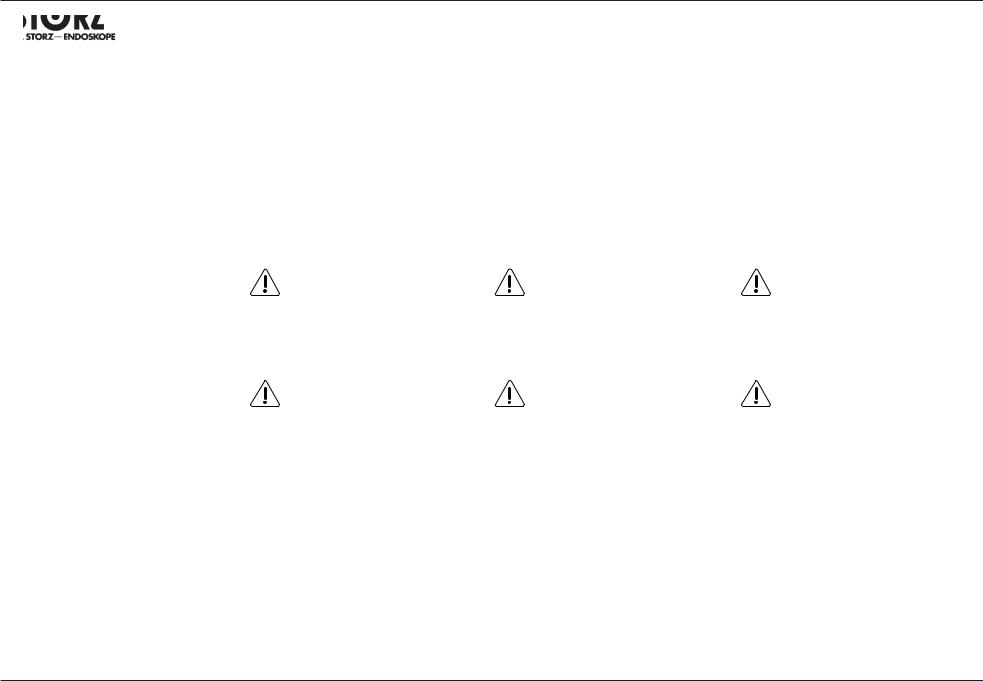
Über diese Anleitung |
About this manual |
Acerca de esta Instrucción |
|
|
|
|
|
|
Symbole und
Gefahrenhinweise
Bitte lesen Sie diese Anleitung sorgfältig durch, und beachten die Anweisungen genau. Die Bezeichungen Warnung, Vorsicht und Hinweis haben spezielle Bedeutungen. Wo immer sie in der Anleitung verwendet werden, sollte der nachfolgende Text genau gelesen werden, um einen sicheren und ef zienten Gebrauch zu gewährleisten. Zur deutlichen Hervorhebung wird
den Bezeichnungen Warnung und Vorsicht ein Piktogramm vorangestellt.
Symbols and hazard information
Please read this manual and follow its instructions carefully. The words Warning, Caution and Note convey special meanings. Wherever they are used in this manual, they should be carefully reviewed to ensure the safe and effective operation of this product. To make the words Warning and Caution stand out more clearly, they are accompanied by a pictogram.
Símbolos e indicaciones de peligro
Lea este manual y siga las instrucciones cuidadosamente. Los términos Cuidado, Advertencia y Nota tienen signi cados muy especiales. Cuando aparezcan en alguna parte de este manual, revise esa sección cuidadosamente para asegurar la operación inocua y e caz de este producto. Para destacar más claramente los términos Cuidado y Advertencia, los mismos están precedidos por un pictograma adicional.
Warnung: Warnung macht auf eine Gefährdung des Patienten oder des Personals aufmerksam. Die Nichtbeachtung einer Warnung kann Verletzungen des Patienten oder des Personals zur Folge haben.
Vorsicht: Vorsicht macht darauf aufmerksam, dass bestimmte Maßnahmen zu treffen sind, um eine Beschädigung des Instrumentariums zu vermeiden.
Hinweis: Hinweise enthalten spezielle Informationen zur Bedienung, oder sie erklären wichtige Informationen.
Warning: A Warning indicates that the personal safety of the patient or physician may be involved. Disregarding a Warning could result an injury to the patient or physician.
Caution: A Caution indicates that particular service procedures or precautions must be followed to avoid possible damage to the instrument.
Note: A Note indicates special information about operating the instrument or clari es important information.
Cuidado: El término Cuidado llama la atención sobre una situación de peligro para el paciente o para el médico. La inobservancia de este aviso podría conllevar lesiones para el paciente o para el médico.
Advertencia: El término Advertencia llama la atención sobre determinadas medidas de mantenimiento o de seguridad que han de llevarse a cabo a n de evitar el deterioro del aparato.
Nota: Los párrafos denominados con el término Nota contienen informaciones especiales para el manejo del equipo o aclaran informaciones importantes.
6
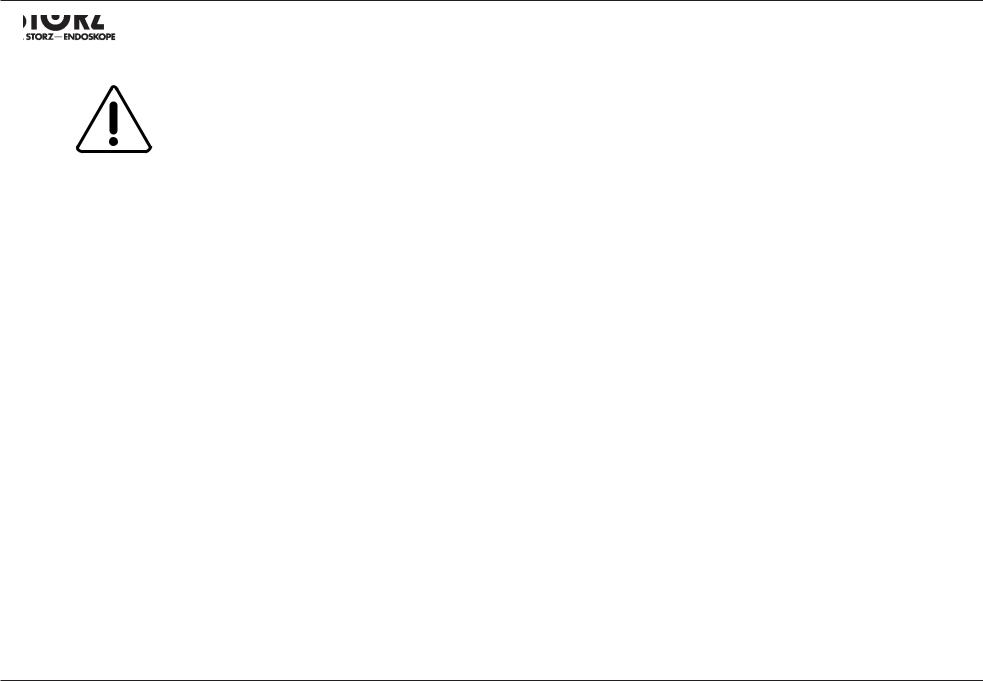
Über diese Anleitung |
About this manual |
Acerca de esta Instrucción |
|
|
|
|
|
|
Sicherheitshinweise
Warnung: Der einwandfreie Zustand der Instrumente muss vor jeder Anwendung sichergestellt werden. Bei Anzeichen von Beschädigungen darf das Instrument keinesfalls weiterverwendet werden.
Warnung: Dieses Instrument wird nicht steril ausgeliefert und muss somit vor der ersten Anwendung sowie vor jeder weiteren Nutzung gereinigt, desin ziert bzw. sterilisiert werden.
Warnung: Während der Applikation muss sich die Instrumentenspitze im Sichtfeld des Anwenders be nden.
Warnung: Die genannten Reinigungs-, Desinfektionsund Sterilisationsverfahren garantieren alleine noch keine Desinfektion oder Sterilität. Diese lässt sich nur erzielen, wenn vom Personal nach anerkannten und validierten Aufbereitungsverfahren vorgegangen wird.
Warnung: Bei allen Reinigungsund Desinfektionsarbeiten an kontaminierten Endoskopen und Instrumenten sind die Richtlinien der Berufsgenossenschaft und gleichranigiger Organisationen zu beachten
Warnung: Beachten Sie, dass eine Sterilisation nur dann erfolgreich durchführbar ist, wenn
-die Instrumente von allen organischen Materialien und Reinigungsrückständen befreit sind. Eine erfolgreiche Sterilisation ist nur an sauberen und desin zierten Ober ächen sichergestellt.
-nach anerkannten und validierten Verfahren gearbeitet wird.
-die empfohlenen Sterilisationsparameter eingehalten werden. Diese sind nur bei vorgeschriebener Wartung und Kalibrierung des Sterilisationsgerätes gültig.
Safety information
Warning: Make certain before every application that the instruments are in perfect condition. If there is any sign of damage, the instrument must not be reused.
Warning: This instrument is delivered unsterilized and must therefore be cleaned, disinfected and/or sterilized before the initial application as well as before any further use.
Warning: During the application, the tip of the instrument must remain in the user’s eld of view.
Warning: The listed cleaning, disinfection and sterilization methods alone do not guarantee disinfection or sterility. This can only be achieved if the staff follows recognized and validated preparation methods.
Warning: For all cleaning and disinfection procedures on contaminated endoscopes and instruments, the guidelines of the Employer’s Liability Insurance Association and equivalent organizations must be observed.
Warning: Remember that sterilization is only then successful if:
-the instruments have been freed of all organic materials and cleaning residues. Successful sterilization is only possible on clean, disinfected surfaces;
-work proceeds according to recognized and validated methods;
-the recommended sterilization parameters are maintained. These are only valid with sterilization equipment that is properly maintained and calibrated.
Instrucciones de seguridad
Cuidado: Antes de cada aplicación debe comprobarse el perfecto estado del instrumento. No siga utilizando en ningún caso el instrumento si presenta señales de deterioro.
Cuidado: Este instrumento no se entrega esterilizado y debe ser, por ello, limpiado, desinfectado o esterilizado antes de la primera aplicación, así como antes de cada aplicación subsiguiente.
Cuidado: Durante la aplicación, la punta del instrumento debe encontrarse dentro del campo visual del usuario.
Cuidado: Los procedimientos mencionados de limpieza, desinfección y esterilización no garantizan por sí solos la desinfección o esterilización. Para conseguirlas, es preciso que el personal aplique los métodos de preparación reconocidos y validados.
Cuidado: Al efectuar trabajos de limpieza y desinfección en endoscopios e instrumentos contaminados, observe las directivas de la mutua de previsión contra accidentes y otras organizaciones equivalentes.
Cuidado: Tenga en cuenta que una esterilización sólo podrá llevarse a cabo exitosamente si
-los instrumentos están libres de materiales orgánicos y residuos de limpieza. Únicamente sobre super cies limpias y desinfectadas es posible asegurar una esterilización e caz.
-se trabaja siguiendo los procedimientos reconocidos y validados.
-se respetan los parámetros de esterilización recomendados. Los mismos sólo son válidos con equipos de esterilización que se hayan mantenido y calibrado correctamente.
7
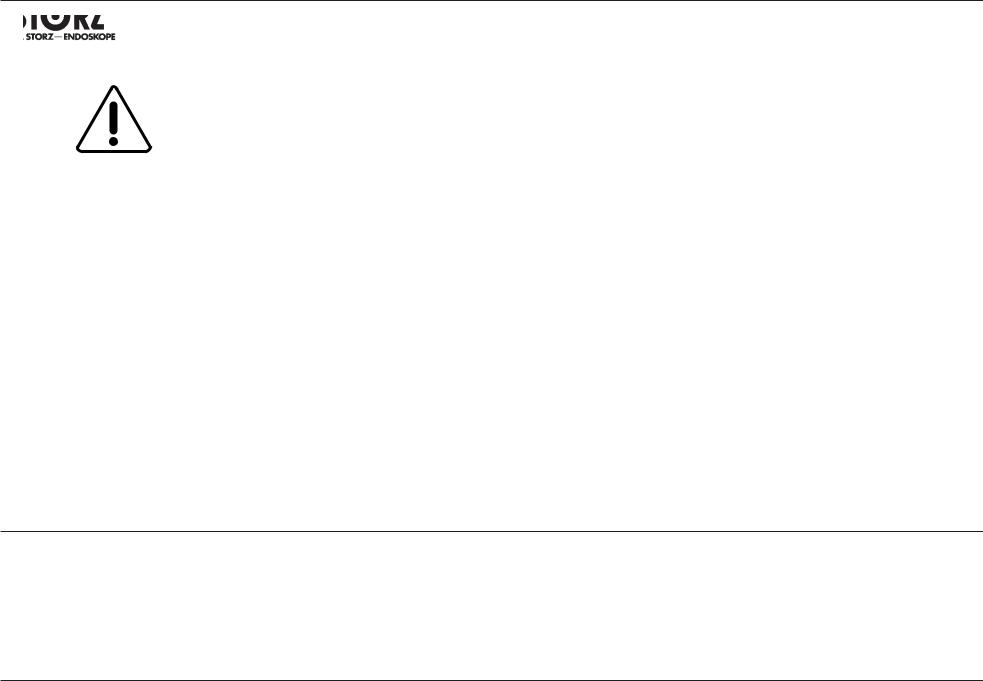
Über diese Anleitung |
About this manual |
Acerca de esta Instrucción |
|
|
|
|
|
|
Vorsicht: Die Verwendung anderer als der hier aufgeführten Aufbereitungsverfahren kann sich negativ auf Funktion und Lebensdauer auswirken. Sämtliche daraus resultierende Schäden sind nicht durch die Garantie abgedeckt.
Vorsicht: Die folgenden Hinweise zur Aufbereitung gelten nur für das in dieser Anleitung beschriebene thermostabile lnstrumentarium. Für HOPKlNS-Optiken und Fiberskope gelten besondere Richtlinien (siehe Anleitungen „Optiken“ und „Fiberskope“).
Vorsicht: Bei der Herstellung und Anwendung der Lösungen sind die Angaben des Herstellers über Konzentration und Einwirkzeit genauestens zu beachten. Eine maximale Einlegedauer von 60 Minuten, einschließlich sterilem Wasser, darf nicht überschritten werden. Zu langes Einlegen kann zu Korrosions- / Materialschäden führen.
Vorsicht: Der ständige Wechsel zwischen verschiedenen Aufbereitungsverfahren bedeutet eine besondere Belastung der Materialien und ist daher zu vermeiden. Eine einmalige Verfahrensänderung, z. B. durch Neuanschaffung von Geräten, ist jedoch möglich.
Caution: Use of preparation methods other than those listed here may have a negative effect on the function and service life. All damages resulting from this are not covered by the guarantee.
Caution: The following information on cleaning and sterilization only applies to the thermostable instrument set described in these instructions.
For HOPKINS telescopes and berscopes, special rules apply (see instructions for ‘telescopes’ and ‘ berscopes’).
Caution: For the production and application of solutions, precisely observe the information from the manufacturer regarding concentration and exposure times. A maximum immersion time of 60 minutes, including sterile water, must not be exceeded. Prolonged immersion can lead to corrosion and/or material damage.
Caution: Constant change between various preparation methods is especially hard on the materials and must therefore be avoided. A onetime change of method, due to procurement of new cleaning and sterilization equipment for example, is however possible.
Advertencia:La utilización de otros procedimientos de preparación diferentes a los aquí expuestos puede tener efectos negativos sobre el funcionamiento y la durabilidad de los instrumentos. Cualquier deterioro resultante de los mismos no está cubierto por la garantía.
Advertencia: Las instrucciones siguientes de limpieza y esterilización son válidas únicamente para el instrumental termoestable descrito en esta Instrucción. Para los telescopios HOPKINS y losbroscopios existen directivas especiales (véanse las Instrucciones “Telescopios” y “Fibroscopios”).
Advertencia: Durante la preparación y aplicación de soluciones deben observarse con la mayor exactitud las indicaciones del fabricante en cuanto a relación de la mezcla y duración de la inmersión. No debe superarse un tiempo máximo de inmersión de 60 minutos, incluyendo el agua esterilizada. Una inmersión demasiado prolongada puede provocar corrosión/deterioro del material.
Advertencia: El cambio continuo entre diferentes procedimientos de preparación signi ca una carga considerable para los materiales y debe, por tanto, evitarse. No obstante, es posible una modi cación excepcional de procedimiento en el caso, por ejemplo, de haberse adquirido nuevos aparatos.
Die Richtlinien der Berufsgenossenschaft und gleichrangiger Organisationen sind zu beachten.
Observe the guidelines of the Employer’s Liability Insurance Association and equal ranking organizations.
Observe las directivas de la mutua de previsión contra accidentes y otras organizaciones equivalentes.
8
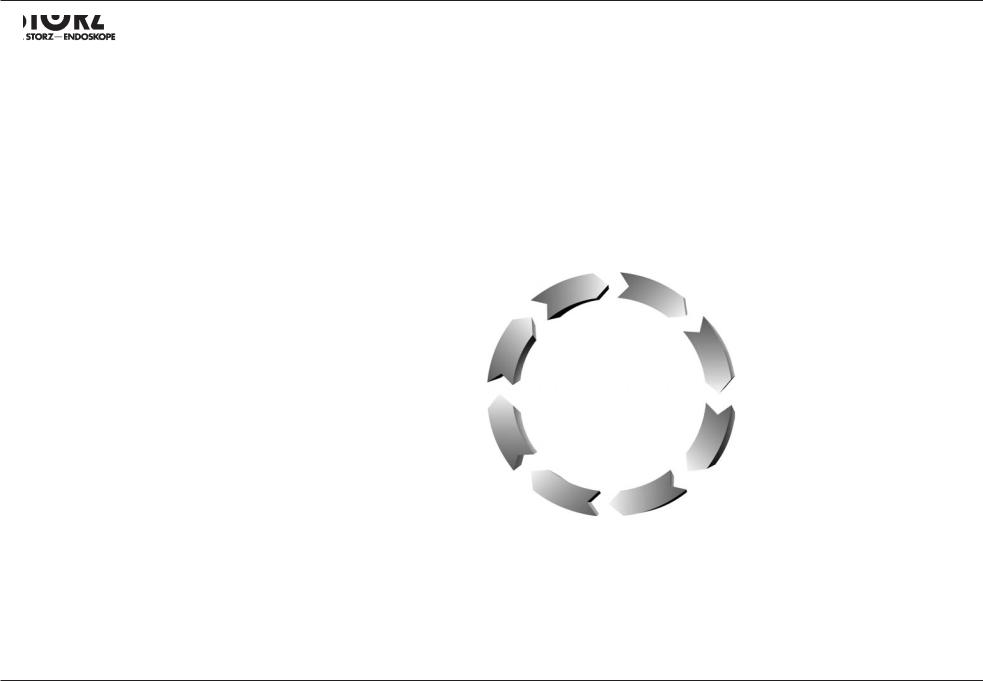
Über diese Anleitung |
About this manual |
Acerca de esta Instrucción |
|
|
|
|
|
|
Generelle Hinweise zur Reinigung, Desinfektion und Sterilisation
Der nachfolgend dargestellte Medizinproduktekreislauf veranschaulicht die Abfolge der verschiedenen Stationen einer sinnvollen Instrumentenaufbereitung:
General instructions on cleaning, disinfection and sterilization
The medical device cycle shown below illustrates the sequence of steps for advisable instrument preparation:
Instrucciones generales para la limpieza, desinfección y esterilización
El circuito representado a continuación para productos médicos ejempli ca la secuencia sucesiva de las diferentes etapas de una preparación correcta de instrumentos:
Lagerung/Storage/
Almacenamiento
Sterilisation/Sterilization/
Esterilización
Verpackung/Packaging/
Envasado
Wartung & P ege, Funktions- & Sicherheitprüfung/ Maintenance and care, functional and safety inspection/Mantenimiento y conservación, veri cación de funcionamiento y de seguridad
Bereitstellung/Provision/Puesta a disposición
Nutzung/Use/Utilización
Entsorgung aus OP – Aufnahme in SterilisationsAbteilung/Removal from OR – receipt by sterilization department/Retirada del quirófano – recepción en el departamento de esterilización
Reinigung und Desinfektion/Cleaning and disinfection/ Limpieza y desinfección
9
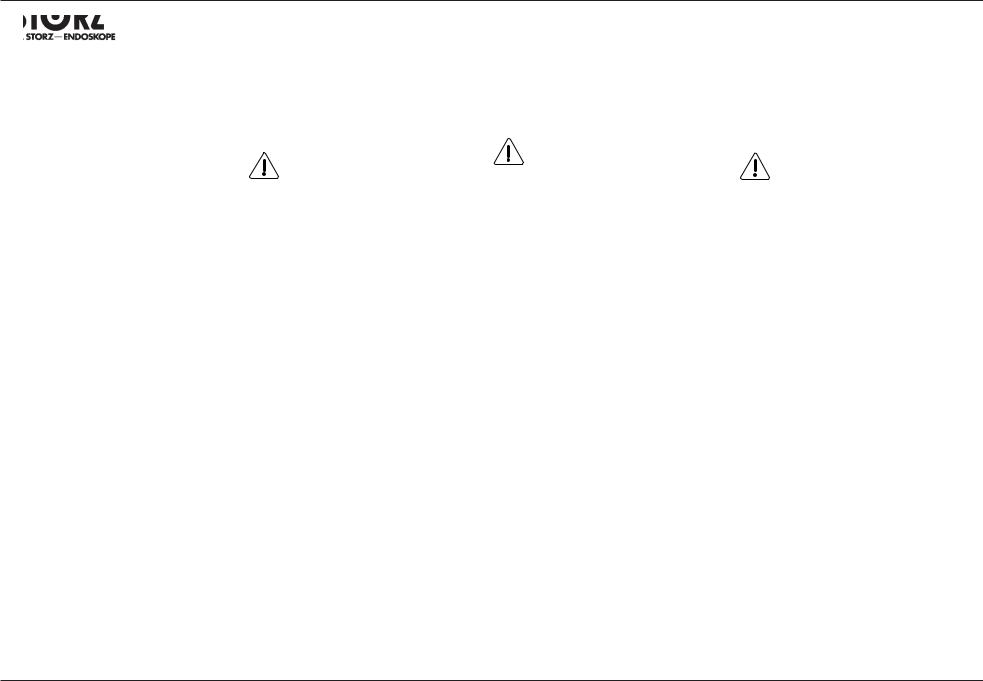
Über diese Anleitung |
About this manual |
Acerca de esta Instrucción |
|
|
|
|
|
|
Entsprechend dem Instrumentenkreislauf gliedert sich die Aufbereitung der hier beschriebenen Instrumente in der Regel in folgende 6 Schritte:
Vorsicht: Die Hinweise zur Reinigung und Sterilisation in der Anleitung „Reinigung, Sterilisation und P ege von KARL STORZ Instrumenten“ müssen beachtet werden. Dort sind die Verfahren zur Reinigung, Desinfektion und Sterilisation im Detail erklärt.
Hinweis: Empfohlenes Reinigungszubehör und Sterilisationscontainer sind im Katalogkapitel „Reinigung, Sterilisation und P ege“ zu nden
According to the instrument cycle, preparation of |
Por lo general y conforme al ciclo de aplicación, la |
the instruments described here generally |
preparación del instrumental aquí descrito puede |
comprises the following 6 steps: |
desglosarse en los siguientes 6 pasos: |
Caution: The instructions for cleaning and sterilization in the manual ‘Cleaning, sterilization and care of KARL STORZ instruments’ must be observed. The methods for cleaning, disinfection and sterilization are explained therein in detail.
Note: Recommended cleaning accessories and sterilization containers can be found in the catalog Section ‘Cleaning, sterilization and care’.
Advertencia: Observe las indicaciones para limpieza y esterilización en la Instrucción “Limpieza, esterilización y conservación de los instrumentos KARL STORZ”. Allí se explican detalladamente los procedimientos para limpieza, desinfección y esterilización.
Nota: En el capítulo “Limpieza, esterilización y conservación” encontrará los accesorios de limpieza y contenedores de esterilización recomendados.
1. Manuelle Vorreinigung
Gegebenenfalls erfordern die Instrumente aufgrund ihrer konstruktiven Auslegung (Spalten, lange enge Lumen etc.) sowie abhängig von Art und Grad der Verschmutzung, einen manuellen Vorreinigungsschritt.
Weiterhin kann eine längere Wartezeit bis zur Aufbereitung (= Antrocknungszeit der Kontamination) eine erste Vorreinigung bereits im OP erforderlich machen, wobei Rückstände organischer Art sowie z .B. von Arzneimitteln
mechanisch mit einem befeuchteten Einmaltuch ( keine alkoholhaltigen Schnelldesinfektionsmittel ) oder mit einer mit aktiver Reinigungslösung befüllten Injektionshilfe entfernt bzw. abgespült werden. Grundsätzlich sind gebrauchte bzw. kontaminierte Instrumente schnellstmöglich aufzubereiten.
Hierbei müssen zerlegbare Instrumente entsprechend den Angaben demontiert werden. Gelenkinstrumente und Scheren müssen in geöffnetem Zustand behandelt werden.
An den Maulteilen anklebende oder fest anhaftende Gewebereste mit einer Reinigungsbürste entfernen. Inkrustierungen sollten schnellstmöglich mit einer mit 3%iger Wasserstoffperoxidlösung befeuchteten Einmalkompresse entfernt werden. Den Maulteilen ist bei der Reinigung besondere Sorgfalt zu widmen, da es sich um feinmechanische Präzisionsteile handelt.
1. Manual preliminary cleaning
The instruments may require manual preliminary cleaning on account of their design (e.g., slits and long, narrow lumens) and depending on the type and degree of soiling.
In addition, a long waiting period before preparation (= which allows contaminations to dry out) may require a preliminary cleaning to be performed in the operating room rst, whereby organic residues, e.g., from pharmaceuticals, can be removed with a moistened cloth (no rapidaction disinfectant containing alcohol) or rinsed off with the help of an injection aid lled with active cleaning solution. Used and contaminated instruments should always be prepared with the minimum possible delay.
Take-apart instruments must be disassembled following the instructions. Articulating instruments and scissors must be treated whilst open. Tissue remnants sticking or caked to the jaws must be removed with a cleaning brush. Incrustations should be removed as quickly as possible with a disposable surgical pad moistened with
a 3% hydrogen peroxide solution. Special care must be taken when cleaning the jaws, as they are precision-engineered parts.
1. Limpieza previa manual
En determinados casos y debido a su diseño constructivo (aberturas, lumen estrecho y largo, etc.), así como dependiendo del tipo y grado de suciedad, algunos instrumentos requieren una limpieza previa manual.
Asimismo, un período prolongado de espera antes de la preparación (= período de secado de la contaminación) hace necesaria una limpieza previa ya en el quirófano, en la cual se eliminan o enjuagan los residuos de tipo orgánico, tales como, p. ej., medicamentos, utilizando al efecto un paño desechable humedecido (no usar ningún producto para desinfección rápida con contenido de alcohol) o una jeringa llena con una solución activa de limpieza. En principio, los instrumentos usados
o contaminados deben prepararse lo más pronto posible.
Al hacerlo, los instrumentos desarmables deben desmontarse siguiendo las indicaciones respectivas. Los instrumentos con articulación y las tijeras deben tratarse estando abiertos.
Elimine los residuos de tejido adheridos o solidi - cados en las mordazas con un cepillo de limpieza. Las incrustaciones deben eliminarse lo antes posible con una compresa desechable humedecida con una solución de peróxido de hidrógeno al 3%. Al efectuar la limpieza, dedique particular esmero a las mordazas, dado que se trata de piezas de precisión de mecánica muy delicada.
10
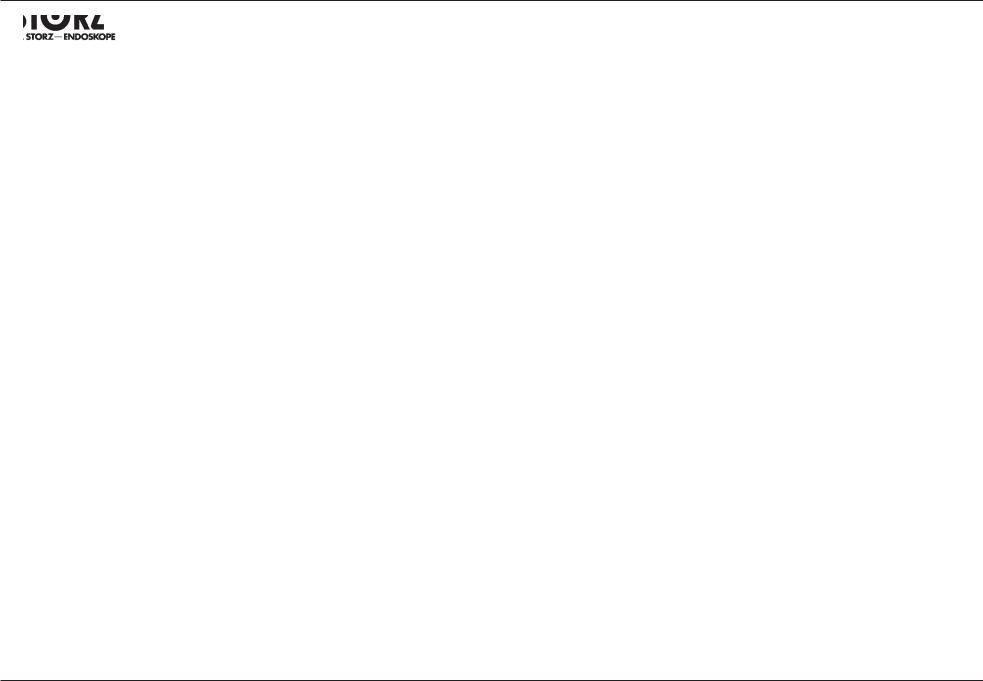
Über diese Anleitung |
About this manual |
Acerca de esta Instrucción |
|
|
|
|
|
|
2. Ultraschallbehandlung
Alle nicht zerlegbaren Scheren, Koagulationsinstrumente, sowie Mikroinstrumente sollten mit Ultraschall vorgereinigt werden (3 – 5 Min. Einwirkzeit).
Die Reinigungswirkung des Ultraschalls erreicht auch schwer zugängliche Hohlräume. Deshalb sind alle nicht zerlegbaren Scheren und Zangen mit und ohne Spülkanal, Schienenschaftinstrumente, Sauger, Zirkularstanzen, Koagulationsinstrumente sowie Mikroinstrumente mit Ultraschall vorzureinigen. An Weichkunststoffteilen hat der Ultraschall keine Reinigungswirkung, weil die Schwingungen gedämpft werden. Hohlkörperinstrumente (Sauger etc.) schräg ins Ultraschallbad halten, damit sich die Hohlräume füllen können. Groß ächige Instrumente sind so im Bad zu positionieren, dass sich keine Schallschatten bilden. Für das Ultraschallbad ungeeignet sind u.a. alle starren und exiblen Optiken, elektrische Geräte, Kabel, Prismen, Gummiartikel, Magnetplatten und Lichtleiter.
Nach der Ultraschallbehandlung gründlich abspülen.
Das Ablegen der Instrumente erfolgt in einem geeigneten Instrumententräger (z.B. Siebkorb).
Hinweis: Falls Schritte einer manuellen Vorreinigung zwingend erforderlich sind, sind diese beim jeweiligen Instrument in dieser Anleitung erläutert.
2. Ultrasound treatment
All non-take-apart scissors, coagulation instruments and microinstruments must be precleaned with ultrasound (3 - 5 minutes exposure time). The cleaning effect of the ultrasound bath reaches even inaccessible hollow spaces. For this reason, all non-take-apart scissors and forceps, with or without irrigation channel, railsheath instruments, aspirators, circular punches, coagulation instruments and microinstruments must be preliminary cleaned with ultrasound. Ultrasound has no cleaning effect on soft plastic parts because the oscillations are attenuated. Hollow instruments (aspirators, etc.) should be held at an angle in the ultrasound bath so that the hollow spaces can ll. Position large instruments in the bath so that no acoustic shadows are formed. The following items, amongst others, are not suitable for cleaning in an ultrasound bath: all rigid and exible telescopes, electrical devices, cables, prisms, rubber articles, magnetic discs and beroptic light cables.
After ultrasound treatment, rinse thoroughly with completely demineralized water.
Place the instruments in a suitable instrument carrier (e.g., a tray holder).
Note: If manual preliminary cleaning is mandatory, the necessary steps are explained in this manual for each instrument.
2. Tratamiento con ultrasonidos
Todos los instrumentos no desmontables, tales como tijeras, instrumentos de coagulación e instrumentos en miniatura, deben limpiarse previamente con ultrasonidos (3 a 5 min. de tiempo de aplicación). El efecto de limpieza de los ultrasonidos alcanza también los espacios huecos de difícil acceso. Por ello, todas las tijeras y pinzas con y sin canal de irrigación, no desmontables, instrumentos con vaina guía, succionadores, punzones circulares, instrumentos de coagulación, así como los instrumentos en miniatura deben limpiarse con ultrasonidos. En las piezas de material sintético blando, los ultrasonidos no tienen ningún efecto limpiador porque las vibraciones son absorbidas. Sostenga en posición oblicua los instrumentos con cuerpo hueco (succionador, etc.) en el baño de ultrasonidos, a n de que puedan llenarse las cavidades. Los instrumentos de gran super cie han de posicionarse en el baño de modo tal que no se formen sombras acústicas. Todos los telescopios rígidos y exibles, aparatos eléctricos, cables, prismas, artículos de goma, placas magnéticas y portaluces, entre otros, no son apropiados para el baño de ultrasonidos.
Después del tratamiento de ultrasonidos, enjuague minuciosamente.
Los instrumentos deben depositarse en un recipiente apropiado (p. ej., cesta perforada).
Nota: Si es absolutamente necesario llevar a cabo una limpieza manual previa, los pasos operativos al efecto se detallan en esta Instrucción para el instrumento respectivo.
3. Manuelle/maschinelle Reinigung und Desinfektion
Zur Aufbereitung müssen mehrteilige Instrumente zerlegt, Dichtungen, Hahnreiber und Schutzkappen entfernt werden.
Manuelle Reinigung/desin zierende
Reinigung
Zur manuellen Reinigung bzw. desin zierenden Reinigung sind reinigungsaktive, nicht protein - xierende Chemikalien, ggf. mit nachgewiesenem Wirkungsspektrum (Listung DGHM oder vergleichbare) einzusetzen.
3. Manual/Machine cleaning and disinfection
For preparation, multi-part instruments must be dismantled, and seals, cock plugs and protective caps removed.
Manual cleaning/Disinfecting cleaning
For manual cleaning or disinfecting cleaning, use active-cleaning, non-protein- xing chemicals, where necessary with a veri ed range of action (DGHM (German Association of Hygiene and Microbiology) listing or comparable).
3. Limpieza y desinfección manual/ mecánica
Para la preparación deben desmontarse los instrumentos formados por varias piezas, y retirarse las juntas, los machos de llave y las caperuzas de protección.
Limpieza manual/limpieza desinfectante
Para la limpieza manual o la limpieza desinfectante deben utilizarse productos químicos con efecto limpiador activo, sin jación proteínica; si es necesario, con espectro comprobado de efectividad (listado DGHM o similar).
11
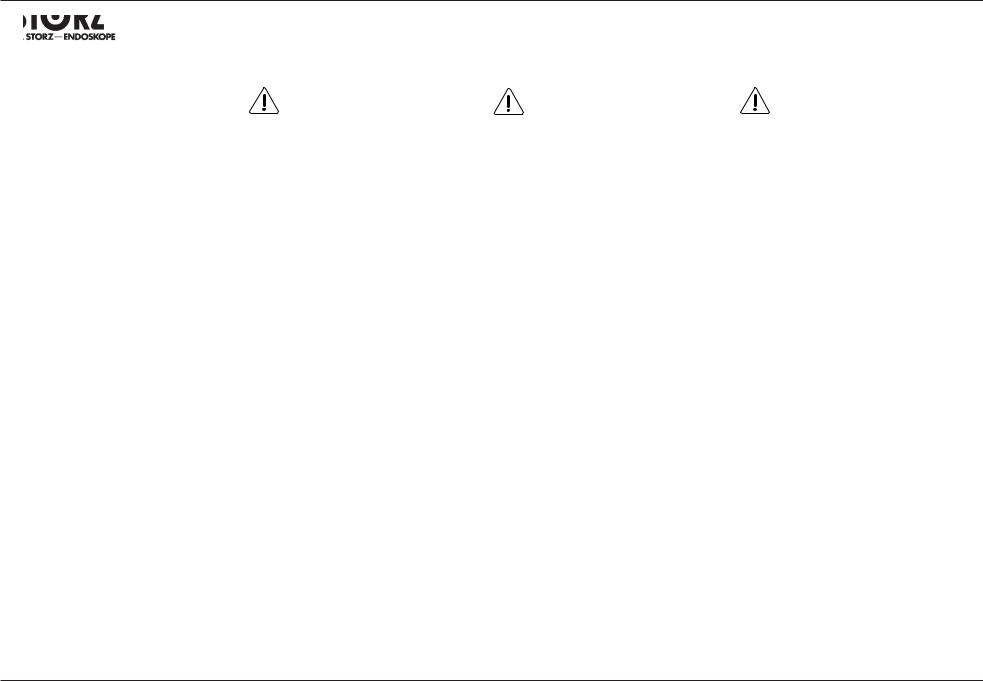
Über diese Anleitung |
About this manual |
Acerca de esta Instrucción |
|
|
|
|
|
|
Vorsicht: Bei der Herstellung und Anwendung der Lösungen sind die Angaben des Herstellers über Konzentration und Einwirkzeit genauestens zu beachten. Zu langes Einlegen kann zu Beschädigungen führen.
Hinweis: Ein Auszug aus der Liste der von KARL STORZ freigegebenen Mittel zur manuellen Reinigung/ Desinfektion nden Sie im Anhang dieser Anleitung und im Internet (www. karlstorz.com).
Beim Einlegen von Instrumenten in Reinigungsund Desinfektionslösungen darauf achten, dass Luft aus den Hohlräumen entweichen kann, so dass alle innenliegenden Flächen vollständig benetzt werden. Dazu Instrumente am besten schräg eintauchen, bis keine Luftblasen mehr zu sehen sind. Grundsätzlich ist bei der Reinigung darauf zu achten, dass sich der Vorgang insbesondere auch auf alle Hohlräume erstreckt (Schaftlumen, Hähne, Ventile etc.) und dass
diese durchgängig sind (Durch usskontrolle, beispielsweise mit einer Spritze).
Ober ächen, Innenräume sowie Maulteile gründlich mit einer geeigneten weichen, desin zierten Bürste, Schwamm oder Reinigungspistole reinigen und spülen. Kleinteile vorsichtig reinigen.
Mit der Reinigungspistole und Zubehör (Art. Nr. 27660) können Hohlräume besonders gut mit Wasser durchspült und mit medizinisch reiner Druckluft getrocknet werden.
Nach der Reinigung Instrumente ausgiebig mit mikrobiologisch einwandfreiem/sterilem Wasser spülen und mit medizinisch reiner Druckluft trocknen.
Maschinelle thermische Reinigung und Desinfektion
Soweit es möglich ist, sollte eine maschinelle thermische Reinigungsdesinfektion, gefolgt von einer Dampfsterilisation bei 134 °C statt nden. Der Vorteil der maschinellen Aufbereitung liegt in der Reduzierung der Risiken für das Personal und in der Standardisierung des Reinigungsvorgangs (validierbare bzw. validierte Prozesse werden gefordert).
Caution: When preparing and using the solutions, the manufacturers instructions concerning concentration and exposure time must be strictly adhered to. Prolonged immersion can lead to damage.
Note: An extract from the list of products approved by KARL STORZ for manual cleaning and disinfection can be found in the appendix of this manual and on the Internet (www.karlstorz.com).
When immersing instruments in cleaning and disinfectant solutions, ensure that air can escape from hollow spaces so that all the internal surfaces are completely wetted. It is best to immerse the instruments at an angle until no more air bubbles can be seen. During cleaning, always ensure that all hollow spaces (sheath lumens, stopcocks, valves etc.) are also cleaned and that there are no obstructions ( ow test, for example with a syringe).
Thoroughly clean surfaces, interiors and jaws with a suitable disinfected soft brush, sponge or cleaning gun, and rinse. Take care when cleaning small parts.
The cleaning gun with accessories (Art. no. 27660) is ideal for rinsing out hollow spaces with water and drying them with sterile compressed air.
After cleaning, rinse the instruments copiously with microbiologically pure/sterile water and dry with sterile compressed air.
Thermal cleaning and disinfection in a machine
As far as possible, thermal cleaning/disinfection should be carried out in a machine, followed by steam sterilization at 134°C. The advantage of preparation by machine is that it reduces the risks for personnel and standardizes the cleaning procedure (validatable or validated processes are demanded).
Advertencia: Durante la preparación y aplicación de soluciones deben observarse con la mayor exactitud las indicaciones del fabricante en cuanto a relación de la mezcla y duración de la inmersión. Una inmersión demasiado prolongada puede conllevar deterioros.
Nota: En el Anexo de esta Instrucción y en internet (www.karlstorz.com) encontrará un extracto de la lista de productos autorizados por KARL STORZ para la limpieza/desinfección manuales.
Al depositar los instrumentos en soluciones de limpieza y desinfección, preste atención a que pueda evacuarse el aire de los espacios huecos, a n de que las super cies interiores puedan humedecerse completamente. Para ello, lo más apropiado es introducir los instrumentos oblicuamente, hasta que ya no se vean burbujas de aire. Por principio, durante la limpieza hay que asegurarse de que este procedimiento alcance particularmente a todos los espacios huecos (lumen de la vaina, llaves, válvulas, etc.) y que éstos tengan capacidad de paso (control de circulación,. p. ej., con una jeringa).
Limpie y enjuague minuciosamente las super cies, los espacios interiores, así como las mordazas con un cepillo blando apropiado, una esponja o una pistola de limpieza. Limpie las piezas pequeñas con cuidado.
Con la pistola de limpieza y accesorios (nº de art. 27660) pueden enjuagarse con agua los espacios huecos particularmente bien y secarse después con aire comprimido puro para uso médico. Después de la limpieza enjuague abundamente con agua microbiológicamente pura/esterilizada y seque con aire comprimido puro para uso médico.
Limpieza y desinfección térmico-mecánicas
En tanto sea posible, debe llevarse a cabo una desinfección térmico-mecánica de limpieza, seguida de una esterilización por vapor a 134°C. La ventaja de la preparación mecánica radica en la reducción del riesgo para el personal y la estandarización del procedimiento de limpieza (se exigen procesos validables o validados).
12
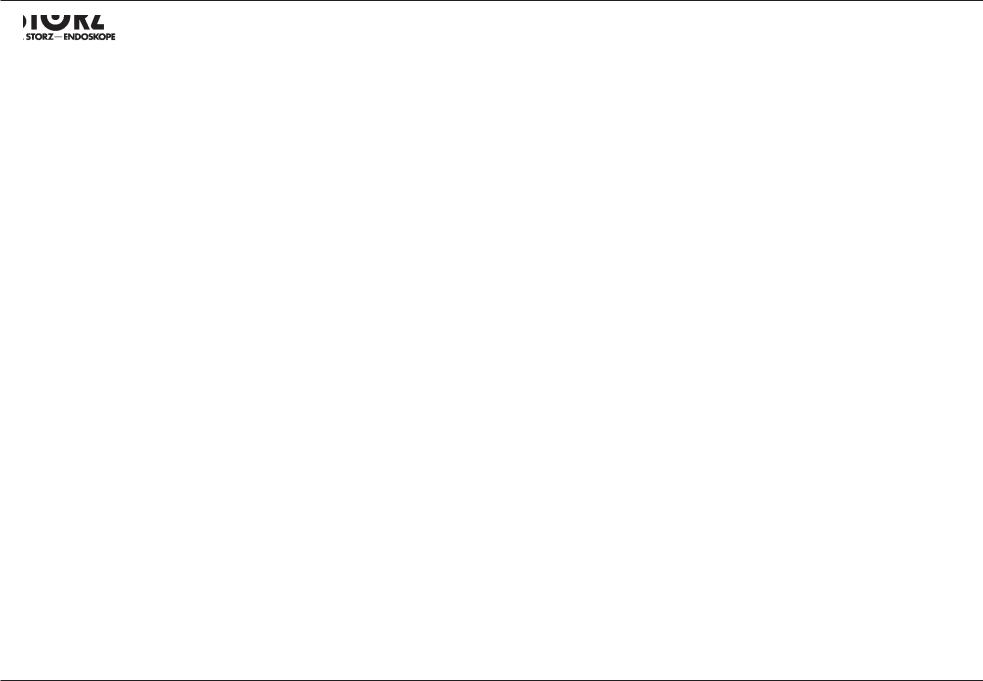
Über diese Anleitung |
About this manual |
Acerca de esta Instrucción |
|
|
|
|
|
|
Durch die teilweise starke Bewegung des Wassers ist es notwendig, dass alle Teile in Haltevorrichtungen xiert werden, die eine Beschädigung verhindern. Für eine ausreichende Durchspülung der Instrumente ist es zwingend notwendig, dass Hohlräume entsprechend an Spülschläuche, Spülaufsätze oder Spülvorrichtungen angeschlossen werden.
Von der Verwendung von P egemitteln in der Maschine ist abzuraten, weil sich Beläge auf den Instrumenten bilden können, oder Kunststoffe durch das P egemittel Schaden erleiden. Eine gezielte, manuelle P ege und Schmierung von Gelenken etc. nach der maschinellen Aufbereitung ist schonender und effektiver.
Eine ausreichende Abschlussspülung mit VEWasser zur restlosen Entfernung von Chemikalienrückständen ist erforderlich.
As there is sometimes strong movement of the water, it is necessary to secure all parts in holding devices to avoid damage. To ensure that the instrument is adequately rinsed out, it is essential to connect up the hollow spaces appropriately to irrigation tubes or irrigation devices.
It is not advisable to use lubricants, etc. in the machine because they may cause deposits to form on the instruments and may damage plastics. Selective manual care and lubrication of joints, etc., is safer and more effective. Adequate nal rinsing with completely demineralized water is required to remove all chemical residues.
Hinweis: Eine Liste der von KARL STORZ freige- |
Note: A list of products approved by |
gebenen Mittel zur maschinellen Reinigung/ Des- |
KARL STORZ for machine cleaning/disinfection |
infektion nden Sie im Anhang dieser Anleitung |
can be found in the appendix of this manual and |
sowie im Internet (www.karlstorz.de). |
on the internet (www.karlstorz.com). |
4. Funktionsprüfung
Alle Instrumente sollen spätestens vor der Sterilisation auf ihre Funktion hin überprüft werden. Diese Funktionskontrolle sollte v.a. nachfolgende Merkmale überprüfen:
•Gängigkeit der Gelenke
•Generelle Abnutzungserscheinungen
•Genaues Schließen der Pinzetten, Klemmen, . Stanzen etc.
•Sicheres Schließen von Ventilen und Dichtungen
•Schärfe der schneidenden Instrumente
•Zustand der Optiken
•Zustand der Isolationsmäntel von Kabeln, ......
auch Kaltlichtkabeln
•Faserbrüche bei Kabeln
Beschädigtes Instrumentarium ist auszusortieren und einer fachgerechten und quali zierten Reparatur zuzuführen. Hierfür empfehlen wir den KARL STORZ Reparatur-Service, der für gleichbleibende Qualität und garantierte Sicherheit Ihrer Instrumente und Geräte verbürgt.
4. Functional testing
All instruments should be checked for correct functioning before sterilization, at the latest. This functional check should include the following aspects in particular:
•Smooth operation of the joints
•General signs of wear
•Exact closing of forceps, clamps and punches, etc.
•Secure closing of valves and seals
•Sharpness of cutting instruments
•Condition of telescopes
•Condition of the insulating sheaths of cables, including cold light cables
•Broken bres in cables
Damaged instruments must be separated out and sent for expert, quali ed repair. For this purpose we recommend the KARL STORZ Repair Service, which ensures consistent quality and guaranteed safety of your instruments and units.
Debido al movimiento parcialmente intenso del agua, es necesario que todas las piezas esténjadas en dispositivos de sujeción, que evitan un posible deterioro de las mismas. Para lograr un enjuague su ciente de los instrumentos es absolutamente imprescindible que los espacios huecos en los tubos exibles, elementos y dispositivos de irrigación estén correspondientemente cerrados. Se recomienda evitar el uso de detergentes en la máquina, ya que podrían depositarse residuos en los instrumentos, o el detergente podría deteriorar los materiales sintéticos. Una conservación y lubricación manuales especí cas de las articulaciones, etc., después de la preparación mecánica, es más cuidadosa.
Es necesario efectuar un abundante enjuaguenal con agua completamente desalinizada para eliminar absolutamente todos los residuos de productos químicos.
Nota: En el Anexo de esta Instrucción y en internet (www.karlstorz.com) encontrará un extracto de la lista de productos autorizados por KARL STORZ para la limpieza/desinfección mecánicas.
4. Veri cación del funcionamiento
Se debe veri car el funcionamiento de todos los instrumentos, a más tardar, antes de la esterilización. Este control debe abarcar, sobre todo, la veri cación de las siguientes características:
•movimiento de las articulaciones
•indicaciones generales de desgaste
•cierre exacto de las pinzas, dispositivos de apriete, punzones, etc.
•cierre seguro de válvulas y juntas
•lo de los instrumentos cortantes
•estado de los telescopios
•estado del recubrimiento aislante de los cables, incluyendo los cables de luz fría
•rotura de bras en los cables
El instrumental deteriorado ha de segregarse y someterse a una reparación especializada y cuali cada. Para ello recomendamos el servicio de reparaciones de KARL STORZ, que responde de la calidad constante y seguridad garantizada de sus instrumentos y aparatos.
13
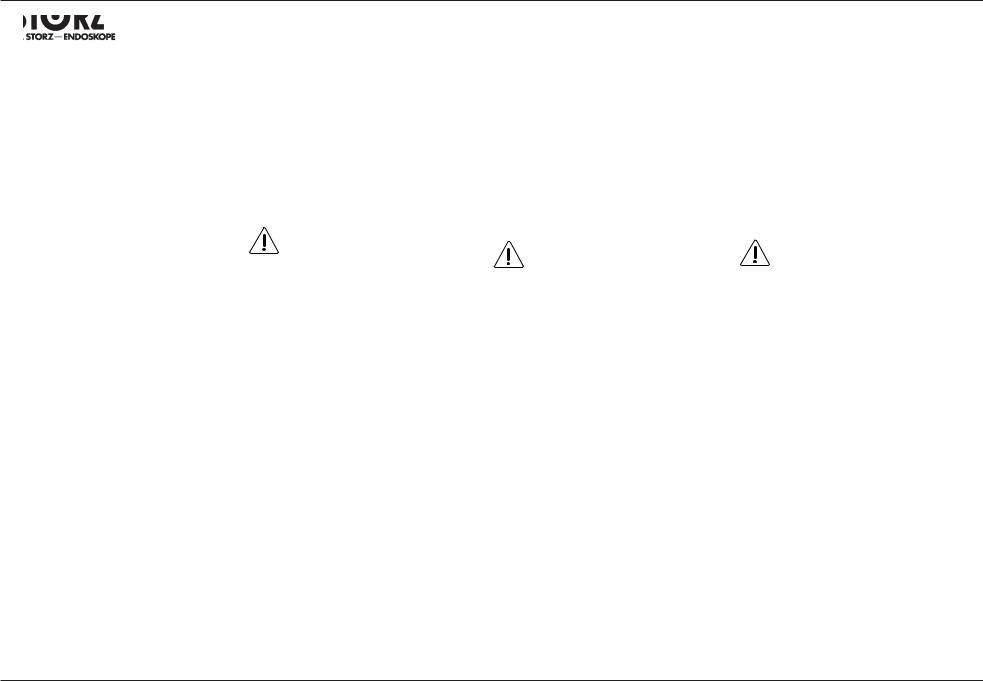
Über diese Anleitung |
About this manual |
Acerca de esta Instrucción |
|
|
|
|
|
|
Instrumente mit Schluss oder Gelenk sind vor ihrer Sterilisation mit dampfsterilisierbaren P e- gemitteln (z.B. Instrumentenöl Art-Nr. 27656 B) zu behandeln.
Hinweis: Dichtungsund Lauf ächen, wie an Hähnen oder Kolben, sind dünn mit Spezialfett (Art.Nr. 27657) zu behandeln. Diese dünne Fettschicht dient nicht nur der Schmierung der aufeinander laufenden Metall-Metall-Ober ächen, sondern auch der Dichtigkeit der Hähne. Öl ist als Dichtmittel nicht geeignet.
Warnung: Nur spezielle Schmiermittel auf Silikonoder Ölbasis verwenden, da die Sterilisiermittel nicht jedes Silikon oder Öl durchdringen können.
5. Sterilisation
Für fast alle Instrumente ist die Dampfsterilisation im fraktionierten Vakuumverfahren bei
134 °C, die Gassterilisation (Formaldehyd, Ethylenoxid), die Plasmasterilisation und die chemische Sterilisation (STERIS) möglich. Die Dampsterilisation mit 134 °C ist meistens das schonendste und kostengünstigste Sterilisationsverfahren. Dies gilt auch für starre Optiken, weil sich bei einer Dampfsterilisation mit 121 °C die längere Einwirkzeit negativ auswirken kann. Eine Sterilisation ist grundsätzlich nur an gereinigten, desin zierten Ober ächen möglich. Fast alle Instrumente können im zusammengebautem Zustand sterilisiert werden. Schrauben und Verschlüsse nur leicht anziehen, damit sie sich später wieder leicht lösen lassen. Hahnrei-
ber vor der Sterilisation lediglich in das Gehäuse einsetzen und nur leicht xieren, noch nicht fest anziehen.
Hinweis: Sollte aufgrund konstruktiver Gegebenheiten eine Sterilisation in demontiertem Zustand erforderlich sein, um die Effektivität der Sterilisation zu gewährleisten, wird beim jeweiligen Artikel in dieser Anleitung ausdrücklich darauf hingewiesen
Für die Dampfsterilisation (mit Sattdampf bei 134 °C + 3 °C) sollten die Verfahren nach EN 285 oder DIN 58946 Teil 1, Ziffer 3.25.2 verwendet werden. Bei Instrumenten mit Lumen sind Vorvakuumverfahren zu verwenden. Der Dampf muss die Anforderungen aus EN 285, Anhang B, erfüllen, um Verfärbungen zu vermeiden.
Prior to sterilization, instruments with a closure mechanism or joint must be treated with lubricants capable of withstanding steam sterilization (e.g., instrument oil Art. no. 27656 B).
Note: Apply a thin coat of special grease to sealing and running surfaces, such as stopcocks and plungers (Art. no. 27657). This thin layer of grease not only serves to lubricate the metal surfaces which are in contact with one another, but also makes the stopcocks leakproof. Oil is not suitable as a sealant.
Warning: Only use special siliconeor oil-based lubricants, as the sterilants cannot penetrate all silicones and oils.
5. Sterilization
For almost all instruments, steam sterilization by the fractionated vacuum method at 134°C, gas sterilization (formaldehyde, ethylene oxide), plasma sterilization and chemical sterilization (STERIS) are possible. Steam sterilization at 134°C is usually the gentlest and most economical method of sterilization. This also applies to rigid telescopes because the longer exposure time for steam sterilization at 121°C can have a negative effect.
Sterilization is only ever possible on surfaces that have been cleaned and disinfected.
Almost all instruments can be sterilized without being dismantled. Only tighten screws and closures gently, so that they are easy to undo later. Insert the valves into the stopcocks and tighten the screws only gently before sterilization.
Note: If the design of the instrument necessitates sterilization in the dismantled state to ensure effectivity, this is expressly stated for the article in question in this manual.
For steam sterilization (with saturated steam at 134°C + 3°C), the process de ned in EN 285 or DIN 58946 Part 1, Number 3.25.2 should be used. Use prevacuum methods for instruments with a lumen. The steam must ful ll the requirements of EN 285, Appendix B, in order to avoid discoloration and stains.
Los instrumentos con cierre o articulación deben tratarse antes de su esterilización con un producto de conservación esterilizable por vapor (p. ej., aceite para instrumentos, nº de art. 27656 B).
Nota: Engrase ligeramente las juntas y las super-cies de deslizamiento, tales como llaves o émbolos, con grasa especial (nº de art. 27657). Esta delgada capa de grasa sirve no solamente para la lubricación de las super cies metálicas que rozan entre sí, sino también para la hermeticidad de la llave. El aceite no es adecuado como agente hermetizante.
Cuidado: Utilice únicamente lubricantes especiales a base de silicona o aceite, dado que los productos para esterilización no pueden atravesarlos.
5. Esterilización
Para casi todos los instrumentos es posible efectuar una esterilización por vapor por el procedimiento fraccionado al vacío a 134°C, por gas (formaldehído, óxido de etileno), por plasma y química (STERIS). La esterilización por vapor a 134°C es, generalmente, el procedimiento de esterilización más cuidadoso y económico. Esto vale también para los telescopios rígidos, porque en caso de una esterilización por vapor a 121°C puede tener efectos negativos debido al prolongado tiempo de aplicación.
Básicamente, una esterilización es posible únicamente sobre super cies limpias y desinfectadas. Casi todos los instrumentos pueden esterilizarse estando montados. Apriete los tornillos y cierres sólo ligeramente, a n de poder a ojarlos después fácilmente de nuevo. Coloque el macho de la llave y fíjelo con el tornillo moleteado. Ajuste ligeramente.
Nota: Si debido a características constructivas fuera necesario efectuar una esterilización en instrumentos desmontados para garantizar la efectividad, en esta instrucción se hace expresa constancia de ello en el artículo respectivo.
Para la esterilización por vapor (con vapor saturado a 134°C +3°C) deben utilizarse los procedimientos según EN 285 ó DIN 58946 parte 1, cifra 3.25.2. En caso de instrumentos con lumen han de utilizarse procedimientos de prevacío. El vapor debe cumplir los requerimientos según EN 285, Anexo B, a n de evitar decoloraciones y manchas.
14
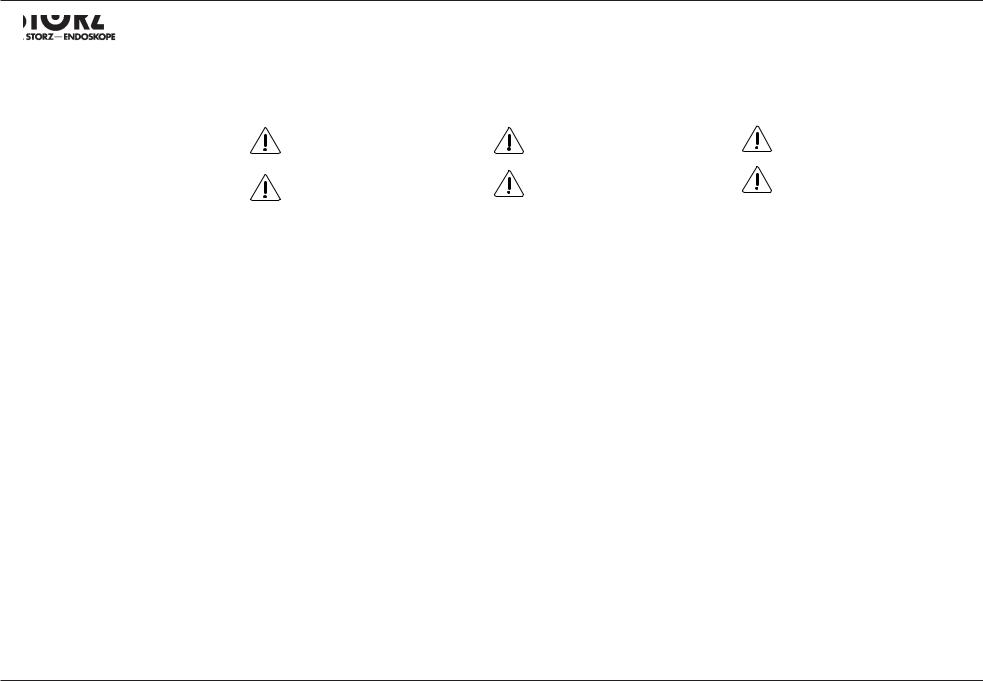
Über diese Anleitung |
About this manual |
Acerca de esta Instrucción |
|
|
|
|
|
|
Diese Verfahren sind auch für die mit «AUTO- |
These procedures are also permissible for |
KLAV» gekennzeichneten Optiken zugelassen. |
telescopes labeled ‘AUTOCLAVE’. |
Vorsicht: Für die Sterilisation von Optiken bitte die Anleitung Optiken beachten.
Warnung: Lange Lumen, Spalten und Kanäle sowie zusammengesetzte Instrumente sind nur mit dem fraktionierten Vorvakuumverfahren uneingeschränkt sterilisierbar.
Caution: When sterilizing telescopes, please follow the instructions in the telescopes manual.
Warning: Long lumens, slits and channels, and assembled instruments can only be sterilized completely with the fractionated prevacuum method.
Estos procedimientos también son admitidos para telescopios identi cados con “AUTOCLAVE”.
Advertencia: Para la esterilización de telescopios observe la Instrucción Telescopios.
Cuidado: Los lúmenes, aberturas y canales largos, así como los instrumentos montados sólo son completamente esterilizables por el procedimiento fraccionado de prevacío.
Da es zahlreiche Varianten der Reinigung, Desinfektion und Sterilisation gibt, ist unbedingt darauf zu achten, dass anerkannte und validierte (geprüfte) Aufbereitungsverfahren zur Anwendung kommen.
Genauere Informationen darüber nden Sie in der Anleitung „Reinigung, Sterilisation und P e- ge von KARL STORZ Instrumenten.“
As there are various types of cleaning, disinfection and sterilization, it is essential to ensure that recognized and validated (tested) preparation methods are used.
Refer to the manual ‘Cleaning, sterilization and care of KARL STORZ instruments’ for more detailed information.
Dado que existen numerosas variantes de limpieza, desinfección y esterilización, ha de prestarse necesariamente atención a que se empleen procedimientos de preparación reconocidos y validados (comprobados).
Información más detallada al respecto encontrará en la Instrucción “Limpieza, esterilización y conservación de los instrumentos KARL STORZ”.
6. Lagerung/Transport
Um Schäden bei Transport und Lagerung zu vermeiden sind die Instrumente sorgfältig in geeignete Haltevorrichtungen abzulegen. Geeignetes Zubehör und Lagerungssysteme sowie Sterilisationstrays für spezielle Instrumententarien nden Sie im Katalog TELEPRESENCE.
6. Storage/Transportation
To avoid damage during transportation and storage, place the instruments carefully in suitable holding devices.
Suitable accessories, storage systems, and sterilization trays for special instrument sets can be found in the relevant Section of the TELEPRESENCE catalog.
6. Almacenamiento/transporte
Con el n de evitar deterioros durante el transporte y almacenamiento, los instrumentos deben depositarse cuidadosamente en dispositivos de sujeción apropiados.
En el catálogo TELEPRESENCE encontrará detallados los accesorios adecuados y los sistemas de almacenamiento, así como los contenedores de esterilización para instrumentos especiales.
15

Trokare |
Trocars for |
Trocares para |
für die Laparoskopie |
laparoscopy |
laparoscopia |
|
|
|
|
|
|
|
|
Konen für offene Laparoskopie |
Cones for open laparoscopy |
|
|
Demontage |
Disassembly |
|
|||
|
|
||
|
|
Dichtungskappe abnehmen, auf Beschädigung |
Take off the sealing cap. Check the sealing cap |
|
|
prüfen, ggf. austauschen. |
for damage, replace if necessary |
|
|
Federkappe herausdrehen. |
Unscrew the spring cap . |
|
|
Kunststoffkonus aus Aufhängung schrauben |
Screw the plastic cone out of the attachment |
|
|
und herausziehen. |
point and pull out. |
Conos para laparoscopia abierta
Desmontaje
Retire la caperuza de junta, compruebe si presenta deterioros y, si es necesario, cámbiela.
Gire hacia afuera la caperuza de muelle . Desatornille el cono de plástico de la suspensión y extráigalo.
|
|
Montage |
|
|
Kunststoffkonus in Aufhängung einschrauben. |
|
||
|
|
Federkappe einschrauben. |
|
|
Dichtungskappe aufsetzen. |
Assembly
Screw the plastic cone into the attachment point.
Screw on the spring cap . Put on the sealing cap.
Montaje
Atornille el cono de plástico en la suspensión. Enrosque la caperuza de muelle .
Monte la caperuza de junta.
Allgemeine Hinweise für |
General information for |
Instrucciones generales para |
||||
Trokare und Zubehör |
trocars and accessories |
trocares y accesorios |
||||
|
Warnung: Wir empfehlen bei spitzen |
|
Warning: For pointed trocar tips, we |
|
Cuidado: Durante el transporte de los |
|
|
Trokardornen, als Transportschutz und |
|
recommend the use of protective caps |
|
instrumentos y también para evitar |
|
|
als Schutz vor Verletzungen, die Ver- |
|
or the protective sleeve 30100 Z for tro- |
|
heridas, en el caso de mandriles de tro- |
|
|
wendung von Schutzkappen oder der |
|
cars sized 6-13 mm (all except 30105 K, |
|
car puntiagudos, recomendamos el uso |
|
|
Schutzhülse 30100 Z für Trokare der |
|
30106 K) for protection during |
|
de caperuzas o casquillos de protección |
|
|
Größe 6 -13 mm (alle außer 30105 K, |
|
transportation and to prevent injuries. |
|
30100 Z para trocares del tamaño 6-13 mm |
|
|
30106 K). |
|
|
|
(todos, excepto 30105 K, 30106 K). |
|
Schutzkappen können auf den einzelnen Dorn |
Protective caps may be placed on the individual |
Las caperuzas de protección pueden colocarse |
||||
oder den kompletten Trokar aufgesetzt werden. |
tip or over the complete trocar. |
sólo sobre el mandril o cubriendo el trocar com- |
||||
|
|
|
|
pleto. |
||
Im Katalog „Laparoskopie“ nden Sie im Kapitel |
In the ‘Laparoscopy’ catalog, you will nd the |
En el catálogo “Laparoscopia” encontrará usted en |
||||
el capítulo “Piezas de repuesto” el número de artí- |
||||||
„Ersatzteile“ die Artikelnummern von Schutz- |
article numbers in the Section ‘Spare parts’ for |
|||||
culo de las caperuzas de protección para |
||||||
kappen für Trokare, im Kapitel „Trokare“ ist die |
protective caps for trocars, while the protective |
|||||
trocares, en el capítulo “Trocares” se describe el |
||||||
Schutzhülse Art.-Nr. 30100 Z (Metall) aufgeführt. |
sleeve Art. no. 30100 Z (metal) is listed in the |
|||||
casquillo de protección, nº de art. 30100 Z (metáli- |
||||||
Die Trokardorne sind auf Beschädigungen und |
‘Trocars’ Section. Check the trocar tips for da- |
|||||
co). Los mandriles de trocar deben comprobarse |
||||||
Schärfe zu prüfen und ggf. auszuwechseln. |
mage and sharpness, and replace if necessary. |
|||||
en cuanto a deterioros y lo y, si es necesario, de- |
||||||
|
|
|
|
|||
|
|
|
|
ben ser reemplazados. |
||
Sterilisation
Trokare und Trokarzubehör sind im zusammengebautem Zustand zu sterilisieren.
Sterilization
Sterilize trocars and trocar accessories in their assembled condition.
Esterilización
Los trocares y sus accesorios deben esterilizarse estando montados.
16

Trokare |
Trocars for |
Trocares para |
für die Laparoskopie |
laparoscopy |
laparoscopia |
|
|
|
|
|
|
Pneumoperitoneum-Kanülen n. VERESS
|
|
|
Demontage |
||
|
|
|
|
Hinweis: Demontage, Reinigung und Montage |
|
|
|
|
|
|
|
|
|
|
|
|
von LUER-Lock-Hähnen siehe „Anweisung für |
|
|
|
|
|
LUER-Lock Hähne“ (Seite 25) |
|
|
|
|
|
|
|
|
|
|
|
Das Außenrohr durch Drehen an der Rände- |
|
|
|
|
|
lung vom Hahngehäuse abschrauben und |
|
|
|
|
|
nach vorne wegziehen. |
VERESS pneumoperitoneum cannulas
Disassembly
Note: Disassembly, cleaning and assembly of LUER-lock stopcocks see ‘Instructions for LUER-lock stopcocks’ (page 25)
Unscrew the outer tube by rotating the knurling on the stopcock housing and pulling off towards the front.
Cánulas para neumoperitoneo seg. VERESS
Nota: Desmontaje, limpieza y montaje de las llaves con cierre LUER, véase la “Instrucción para llaves con cierre LUER” (pág. 25)
Desmontaje
Desenrosque el tubo exterior del cuerpo de la llave mediante giro del moleteado y extráigalo hacia adelante.
Bei der manuellen Reinigung wird der Hahn erst nach dem Durchspülen des Innenrohres zerlegt.
Manuelle Aufbereitung
Schlauch an den LUER-Anschluss anschließen und Schaftrohr innen gut durchspülen, bis kein verunreinigtes Wasser am distalen Ende mehr austritt.
Vor der Sterilisation trocknen mit medizinisch reiner Druckluft.
For manual cleaning, the stopcock is only disassembled after the inside tube has been rinsed out.
Manual preparation
Connect the LUER connector and rinse out the inside of the sheath tube until clear water ows out the distal end.
Dry with sterile compressed air before sterilization.
Cuando se trata de limpieza manual, la llave se desmonta sólo después de enjuagar el tubo interior.
Preparación manual
Conecte el tubo exible a la conexión LUER y enjuague bien el interior del tubo de la vaina, hasta que ya no salga agua sucia por el extremo distal. Seque con aire comprimido puro para uso médico antes de la esterilización.
Maschinelle Reinigung/Desinfektion
Die Rohre müssen innen durchspült werden. Dazu ist ein Spülschlauch der Maschine an den LUER-Anschluss anzuschließen. Über das Außenrohr ist ein passender Schlauch auf die Rändelung zu schieben.
Montage
Die Nadelspitze auf Beschädigungen prüfen. Stumpfe und abgeknickte Nadeln sind auszutauschen.
Machine cleaning/disinfection
The tubes must be rinsed out on the inside. To do this, an irrigation hose from the machine is connected at the LUER connection. Slide a suitable hose onto the knurling over the outer tube.
Assembly
Check the needle tip for damage.
Blunt, bent or broken off needles must be replaced.
Limpieza/desinfección mecánica
Enjuague el interior de los tubos. Para ello conecte un tubo exible de irrigación de la máquina a la conexión con cierre LUER. Sobre el tubo exterior ha de deslizarse un tubo exible adecuado al moleteado.
Montaje
Compruebe si la punta de la aguja presenta deterioros. Cambie las agujas romas o dobladas.
|
|
|
Den Hahnreiber dünn mit Fett bestreichen und |
|
|
|
zusammensetzen. |
|
|
Den Gang des Federmechanismus prüfen. |
|
|
|
|
Das Außenrohr von vorne auf das Innen- |
|
|
|
rohr schieben und verschrauben. Nochmals |
|
|
|
|
|
|
|
den Gang des Federmechanismus prüfen. |
Lightly grease the cock plug and assemble. Check the movement of the spring mechanism. Slide the outer tube onto the inner tube from the front and screw together. Again, check the movement of the spring mechanism.
Lubrique ligeramente con grasa el macho de la llave y móntelo nuevamente.
Compruebe el movimiento del mecanismo de resorte . Deslice el tubo exterior por delante sobre el tubo interior y enrósquelo. Compruebe nuevamente el movimiento del mecanismo de resorte.
17
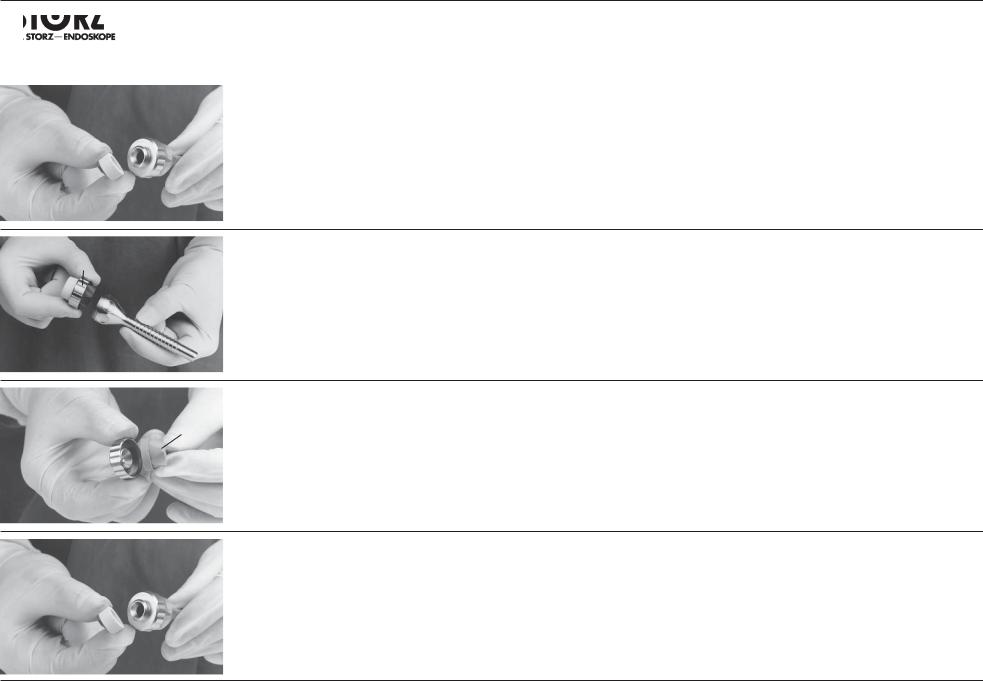
Trokare |
Trocars for |
Trocares para |
für die Laparoskopie |
laparoscopy |
laparoscopia |
|
|
|
|
|
|
Starre Trokare mit Silikonlippenventil 2,5 mm bis 11 mm
Hinweis: Demontage, Reinigung und Montage von LUER-Lock-Hähnen siehe „Anweisung für LUER-Lock Hähne“ (Seite 25)
Demontage
Trokardorn entfernen.
Dichtungskappe abnehmen, auf Beschädigung prüfen, ggf. austauschen.
Rigid trocars with silicone lip valve, 2.5 mm and 11 mm
Note: Disassembly, cleaning and assembly of LUER-lock stopcocks see ‘Instructions for LUER-lock stopcocks’ (page 25)
Disassembly
Remove trocar tip.
Take off sealing cap, check for damage, replace if necessary.
Trocares rígidos con válvula con labio de silicona de 2,5 mm hasta 11 mm
Nota: Desmontaje, limpieza y montaje para llaves con cierre LUER véase la “Instrucción para llaves con cierre LUER” (pág. 25)
Desmontaje
Extraiga el mandril del trocar.
Retire la caperuza de junta, compruebe si presenta deterioros y, si es necesario, cámbiela.
Zum Entfernen des Silikonlippenventils Rändelring abschrauben Silikonlippenventil her-ausnehmen, auf Beschädigung prüfen und ggf.
austauschen.
Hinweis: Wir empfehlen, das Silikonlippenventil nach jedem Gebrauch auszutauschen.
To remove the silicone lip valve , unscrew the knurled ring . Take out the silicone lip valve, check for damage and replace if necessary.
Note: We recommend replacing the silicone lip valve after every use.
Para extraer la válvula con labio de silicona desenrosque el anillo moleteado . Extraiga la válvula con labio de silicona, compruebe si presenta deterioros y, si es necesario, cámbiela.
Nota: Nosotros recomendamos cambiar la válvula con labio de silicona después de cada uso.
|
Montage |
Assembly |
Montaje |
|
Silikonlippenventil in Rändelring einsetzen |
Insert the silicone lip valve into the knurled |
Coloque la válvula con labio de silicona en el |
|
und aufschrauben. |
ring and screw on. |
anillo moleteado y enrósquelo. |
|
Dichtungskappe aufsetzen. |
Put on sealing cap. |
Coloque la caperuza de junta. |
|
Trokardorn einführen. |
Insert the trocar tip. |
Introduzca el mandril del trocar. |
|
Trokarschutzkappe aufsetzen. |
Put on the trocar protective cap. |
Coloque la caperuza de protección del trocar. |
Flexible Trokare mit Silikonlippenventil 9 mm
Demontage
Trokardorn entfernen.
Dichtungskappe abnehmen, auf Beschädigung prüfen, ggf. austauschen.
Flexible trocars with silicone lip valve, 9 mm
Disassembly
Remove trocar tip.
Take off the sealing cap, check for damage, replace if necessary.
Trocares exibles con válvula con labio de silicona de 9 mm
Desmontaje
Extraiga el mandril del trocar.
Retire la caperuza de junta, compruebe si presenta deterioros y, si es necesario, cámbiela.
18
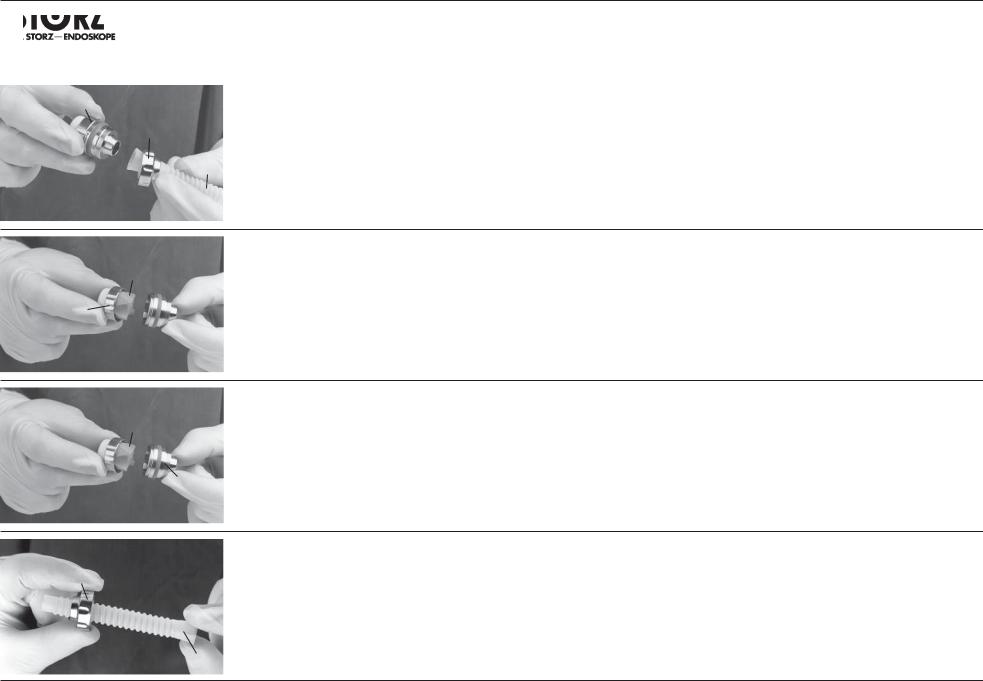
Trokare |
Trocars for |
Trocares para |
für die Laparoskopie |
laparoscopy |
laparoscopia |
|
|
|
|
|
|
Rändelring im Uhrzeigersinn (Linksgewinde)aufdrehen und mit Ventilkopf von exibler Tro-
karhülse abnehmen.
|
Flexible Trokarhülse austauschen. |
|
|
|
|
Turn the knurled ring clockwise (left-handed thread) and remove with the top of the valve from the exible trocar cannula .
Replace the exible trocar cannula.
Gire el anillo moleteado en el sentido de las agujas del reloj (rosca izquierda) y retire el cabezal de la válvula del casquillo exible del trocar . Cambie el casquillo exible del trocar.
|
Zum Entfernen des Silikonlippenventils Rän- |
|
delring aufschrauben. Silikonlippenventil |
|
aus Rändelring herausnehmen, auf Beschädi- |
gung prüfen, ggf. austauschen. |
|
|
Hinweis: Wir empfehlen, das Silikonlippenventil |
|
nach jedem Gebrauch auszutauschen. |
|
To remove the silicone lip valve , screw on the knurled ring . Take the silicone lip valve out of the knurled ring , check for damage, replace if necessary.
Note: We recommend replacing the silicone lip valve after every use.
Para extraer la válvula con labio de silicona desenrosque el anillo moleteado . Extraiga la válvula con labio de silicona del anillo moleteado , compruebe si presenta deterioros y, si es necesario, cámbiela.
Nota: Nosotros recomendamos cambiar la válvula con labio de silicona después de cada uso.
Montage
Silikonlippenventil in Rändelring einsetzen
und auf Kopfteil aufschrauben.

Assembly
Insert the silicone lip valve into the knurled ring and screw onto the top part .
Montaje
Coloque la válvula con labio de silicona en el anillo moleteado y enrósquela a la pieza del cabezal .
|
Rändelring über exible Trokarhülse legen |
Place the knurled ring over the exible trocar |
|
und mit aufgesetztem Ventilkopf verschrau- |
cannula and screw together with the top of |
|
ben. |
the valve in place. |
Dichtungskappe aufsetzen. |
Put on the sealing cap. |
|
|
Trokardorn einführen. |
Insert the trocar tip. |
|
Trokarschutzkappe aufsetzen. |
Put on the trocar protective cap. |
Coloque el anillo moleteado sobre el casquilloexible del trocar y enrósquelo con el cabezal de la válvula colocado.
Coloque la caperuza de junta. Introduzca el mandril del trocar.
Coloque la caperuza de protección del trocar.
19

|
|
|
Trokare |
Trocars for |
Trocares para |
|
|
|
für die Laparoskopie |
laparoscopy |
laparoscopia |
|
|
|
|
|
|
|
|
|
|
|
|
|
|
|
Trokare mit Multifunktionsventil |
Trocars with multifunction valve |
Trocares con válvula multifuncional |
|
|
|
Hinweis: Demontage, Reinigung und Montage |
Note: Disassembly, cleaning and assembly |
Nota: Desmontaje, limpieza y montaje para llaves |
|
|
|
von LUER-Lock-Hähnen siehe „Anweisung für |
of LUER-lock stopcocks see ‘Instructions for |
con cierre LUER véase la “Instrucción para llaves |
|
|
|
LUER-Lock Hähne“ (Seite 25) |
LUER-lock stopcocks’ (page 25) |
con cierre LUER” (pág. 25) |
|
|
Demontage |
Disassembly |
Desmontaje |
|
|
|
|
|||
|
|
|
Extraiga el mandril del trocar. |
||
|
|
|
Trokardorn entfernen. |
Remove trocar tip. |
|
|
|
|
Dichtungskappe abnehmen, auf Beschädigung |
Take off sealing cap, check for damage; replace |
Retire la caperuza de junta, compruebe si presenta |
|
|
|
prüfen, ggf. austauschen. |
if necessary. |
deterioros y, si es necesario, cámbiela. |
|
|
|
Bajonettverschluß an Trokarhülse lösen. |
Loosen bayonet mount on the trocar cannula. |
A oje el cierre de bayoneta en el casquillo del |
|
|
|
Ventilkopf abnehmen. |
Take off the top of the valve . |
trocar. |
|
|
|
|
|
Retire el cabezal de la válvula . |
|
|
|
|
|
|
|
|
|
Der Ventilkopf kann weiter zerlegt werden, um |
The top of the valve may be further disman- |
El cabezal de la válvula puede continuar des- |
|
|
|
die kleine Dichtungskappe, den Stößel oder |
tled in order to replace the small sealing cap, the |
montándose, con el n de cambiar la caperuza |
|
|
|
die innenliegende Dichtung auszutauschen. |
plunger or the inside seal |
pequeña de obturación , el taqué o la junta |
|
|
|
Hierzu Schieber am Hebel des Ventilkopfes |
To do this, pull out the pusher on the lever |
interior . |
|
|
|
nach außen ziehen. |
on the top of the valve . |
Para ello, tire hacia afuera del deslizador en la |
|
|
|
|
|
palanca del cabezal de la válvula . |
|
|
|
|
|
|
|
|
|
|
|
|
|
|
|
|
|
|
|
|
|
|
|
|
Hebel gedrückt halten und Stößel nach |
Keep the lever pressed down and pull out the |
|
|
|
hinten entnehmen. |
plunger towards the back. |
|
|
Bei Trokaren Größe 6 mm (Kennfarbe: schwarz) |
For trocars size 6 mm (color code: black) and |
||
|
|
|||
|
und Größe 7 mm (Kennfarbe: gelb) vorher den |
size 7 mm (color code: yellow), rst unscrew the |
||
|
||||
|
|
hinteren Kopfteil abschrauben. |
rear top part. |
|
|
|
Hinweis: Das hintere Kopfteil lässt sich mit aufge- |
Note: It is easier to unscrew the rear top part if |
|
|
|
setzter Dichtungskappe leichter abschrauben. |
the sealing cap is in place. |
|
|
|
Kleine Dichtungskappe abnehmen. |
Remove the small sealing cap. |
Mantenga presionada hacia abajo la palanca y extraiga hacia atrás el taqué .
En el caso de trocares de tamaño 6 mm (código de color: negro) y tamaño 7 mm (código de color: amarillo) desenrosque primeramente la pieza posterior del cabezal.
Nota: La parte posterior del cabezal puede desenroscarse más fácilmente con la caperuza de junta colocada.
Retire la caperuza pequeña de junta .
Die innenliegende Dichtung auf Beschädigung prüfen, ggf. austauschen. Hierzu Schraube
über der Dichtung im Uhrzeigersinn (Linksgewinde) aufdrehen.
Check the inside seal for damage, replace if necessary. To do this, turn the screw over the seal clockwise (left-handed thread).
Compruebe si la junta interior presenta deterioros; si es necesario, cámbiela. Para ello, abra el tornillo sobre la junta en el sentido de las agujas del reloj (rosca hacia la izquierda).
20
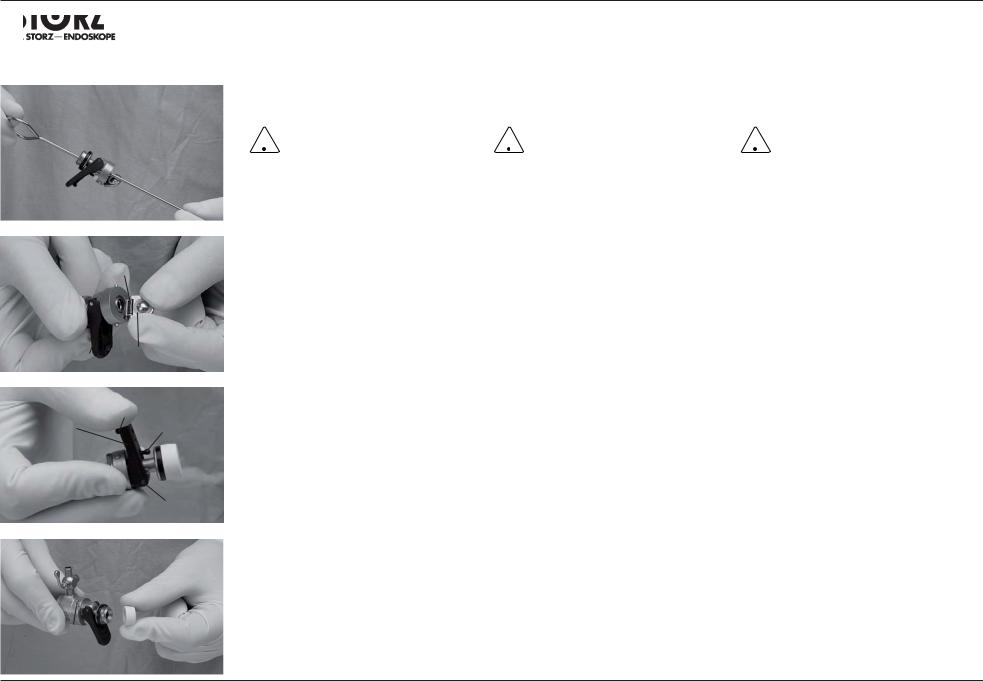
|
|
|
Trokare |
Trocars for |
Trocares para |
||||||
|
|
|
für die Laparoskopie |
laparoscopy |
laparoscopia |
||||||
|
|
|
|
|
|
|
|
|
|
|
|
|
|
|
|
|
|
|
|
|
|
|
|
|
|
|
Manuelle Reinigung |
Manual cleaning |
Limpieza manual |
||||||
|
|
|
Die Ventilklappe bei Reinigung des Ventilkopfes |
Hold the valve ap open when cleaning the top |
Mantenga abierta la válvula de mariposa durante |
||||||
|
|
|
offenhalten. |
of the valve. |
la limpieza del cabezal de la válvula. |
||||||
|
|
|
|
Vorsicht: Ventilklappe vorsichtig reini- |
|
|
Caution: Clean the valve ap carefully, |
|
|
Advertencia: Limpie con sumo cuidado |
|
|
|
|
|
gen, da ein Dejustieren der Ventilklappe |
|
|
since misalignment of the valve ap |
|
|
la mariposa de la válvula, dado que un |
|
|
|
|
|
|
|
||||||
|
|
|
|
die einwandfreie Funktion beeinträchtigt. |
|
|
prevents smooth functioning. |
|
|
desajuste de la misma menoscaba el fun- |
|
|
|
|
Maschinelle Reinigung |
Machine cleaning |
|
|
cionamiento. |
||||
|
|
|
Limpieza mecánica |
||||||||
|
|
|
Die Klappe durch Öffnungsstab (Art.-Nr. 26 G) |
Fix the ap in an open position using the open- |
|||||||
|
|
|
oder eine entsprechende Haltevorrichtung in |
ing rod (Art. no. 26 G) or a suitable holding |
Fije la válvula de mariposa en posición abierta me- |
||||||
|
|
|
offener Position xieren. |
device. |
diante una varilla (nº de art. 26 G) o un dispositivo |
||||||
|
|
|
|
|
|
|
|
que la mantenga abierta. |
|||
|
|
|
|
|
|
|
|
|
|
|
|
|
|
|
Montage |
Assembly |
Montaje |
||||||
|
|
|
Gelenk des Klappenventils und seitliche Auf- |
Oil the joint on the ap valve and lateral |
Aceite la articulación de la válvula de mariposa y |
||||||
|
|
|
hängung der Daumenplatte gezielt ölen. |
attachment point of the thumb plate precisely. |
la suspensión lateral de la placa del pulgar. |
||||||
|
|
|
Falls der Ventilkopf weiter zerlegt wurde: |
If the top of the valve has been further |
Si se ha continuado desmontando el cabezal de |
||||||
|
|
|
Kleine Dichtungskappe aufsetzen. Innenliegen- |
disassembled: |
la válvula: Coloque la caperuza pequeña de junta. |
||||||
|
|
|
de Dichtung in die Einbuchtung der Klappe |
Put on the small sealing cap. Insert the inside |
Coloque la junta interior en la cavidad de la ma- |
||||||
|
|
einlegen und mit Schraube durch Drehen ent- |
seal into the recess in the ap and x in place |
riposa y fíjela con el tornillo , girando en sentido |
|||||||
|
|
|
gegen dem Uhrzeigersinn xieren. Schraube nur |
with the screw by turning counterclockwise. |
contrario al de las agujas del reloj. ¡Apriete el torni- |
||||||
|
|
|
leicht anziehen! |
Tighten the screw only slightly. |
llo sólo ligeramente! |
||||||
|
|
Klappenventil im geschlossenen Zustand auf |
Check the ap valve for correct seating in its |
Estando la válvula de mariposa cerrada, comprue- |
|||||||
|
|||||||||||
|
|
|
korrekten Sitz überprüfen. |
closed condition. |
be que la misma asiente correctamente. |
||||||
|
|
|
|
|
|
|
|
|
|
|
|
|
|
|
Stößel bei gedrückter Daumenplatte von |
With the thumb plate depressed, insert the |
Introduzca el taqué por detrás, teniendo presio- |
||||||
|
|
|
hinten einführen. |
plunger from behind. |
nada la placa del pulgar . |
||||||
|
|
Daumenplatte nachlassen, bis Schieber |
Release the thumb plate until the pusher |
Suelte la placa del pulgar , hasta que el desliza- |
|||||||
|
|
|
|||||||||
|
|
über die kugelförmige Aufnahme geschoben |
can be slid over the ball-shaped holder. |
dor pueda desplazarse sobre el alojamiento en |
|||||||
|
|
||||||||||
|
|
|
werden kann. |
For 6 and 7 mm size trocars, screw on the rear |
forma de bola. |
||||||
|
|
|
Bei Trokaren Größe 6 und 7 mm hinteres Kopfteil |
top part. |
En el caso de trocares de los tamaños 6 y 7 mm, |
||||||
|
|
|
aufschrauben. |
Note: It is easier to screw on the rear top part if |
desenrosque la pieza posterior del cabezal. |
||||||
|
|
|
Hinweis: Das hintere Kopfteil lässt sich mit |
the sealing cap is in place. |
Nota: La pieza posterior del cabezal se puede |
||||||
|
|
|
aufgesetzter Dichtungskappe leichter aufschrau- |
Test for proper operation. |
desenroscar más fácilmente estando la caperuza |
||||||
|
|
ben. |
|
|
|
de junta colocada. |
|||||
|
|
|
|
|
|
||||||
|
|
|
Funktion prüfen. |
|
|
|
Compruebe el funcionamiento. |
||||
|
|
|
|
|
|
|
|
|
|
|
|
|
|
|
Ventilkopf in Trokarhülse einsetzen und Bajo- |
Insert the top of the valve into the trocar |
Coloque el cabezal de la válvula en la vaina del |
||||||
|
|
|
nettverschluß schließen. |
cannula and close the bayonet mount . |
trocar y trabe el cierre de bayoneta . |
||||||
|
|
|
Dichtungskappe aufsetzen. |
Put on the sealing cap. |
Coloque la caperuza de junta. |
||||||
|
|
|
Trokardorn unter Betätigung der Daumenplatte |
Insert the trocar tip while operating the thumb |
Introduzca el mandril del trocar accionando la pla- |
||||||
|
|
|
einführen. |
plate. |
ca del pulgar. |
||||||
|
|
|
|
|
|
|
|
|
|
|
|
21
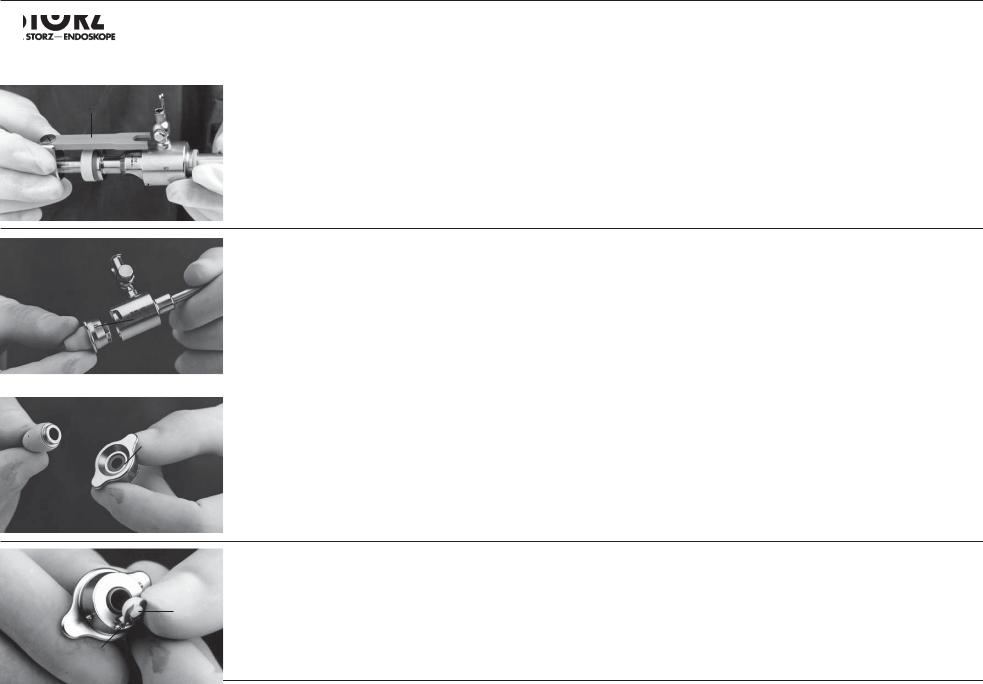
Trokare |
Trocars for |
Trocares para |
für die Laparoskopie |
laparoscopy |
laparoscopia |
|
|
|
|
|
|
Hinweis: Um die korrekte Positionierung der Trokardornspitze der Trokardorne n. REMORGI-
DA zu gewährleisten, muss die Positionierungshilfe am Insuf ationshahn einrasten.
Trokarschutzkappe aufsetzen.
Note: To ensure the correct positioning of the tip of the REMORGIDA trocar tips, the positioning aid must lock into place on the insuf ation stopcock.
Put on the trocar protective cap.
Nota: Para garantizar el correcto posicionamiento de la punta del mandril del trocar de los mandriles de trocar seg. REMORGIDA, debe encastrarse la ayuda de posicionamiento en la llave de insu-ación.
Coloque la caperuza de protección del trocar.
Trokare mit automatischem |
Trocars with automatic ap valve |
Klappenventil < 5 mm |
< 5 mm |
Trocares con válvula automática de mariposa < 5 mm
|
|
|
|
|
|
|
Hinweis: Demontage, Reinigung und Montage |
|
Nota: Desmontaje, limpieza y montaje para llaves |
|
|
|
|
|
|
|
von LUER-Lock-Hähnen siehe „Anweisung für |
Note: Disassembly, cleaning and assembly |
con cierre LUER véase la “Instrucción para llaves |
|
|
|
|
|
|
|
LUER-Lock Hähne“ (Seite 25). |
con cierre LUER” (pág. 25). |
|
|
|
|
|
of LUER-lock stopcocks see ‘Instructions for |
|||||
|
|
|
Demontage |
Desmontaje |
|||||
|
|
|
LUER-lock stopcocks’ (page 25). |
||||||
|
|
|
|
|
|
|
|||
|
|
|
|
|
|
Trokardorn entfernen. |
Disassembly |
Extraiga el mandril del trocar. |
|
|
|
|
|
|
|
|
|||
|
|
|
|
|
|
|
Dichtungskappe abnehmen, auf Beschädigung |
Remove the trocar tip. |
Retire la caperuza de junta, compruebe si |
|
|
|
|
|
|
|
prüfen, ggf. austauschen. |
presenta deterioros y, si es necesario, cámbiela. |
|
|
|
|
|
|
|
|
Take off the sealing cap, check for damage; |
||
|
|
|
|
|
|
|
Bajonettverschluß an Trokarhülse lösen. |
A oje el cierre de bayoneta en la vaina del tro- |
|
|
|
|
|
|
|
|
replace if necessary. |
||
|
|
|
|
|
|
|
Ventilkopf abnehmen. |
car. Retire el cabezal de la válvula . |
|
|
|
|
|
|
|
|
Loosen the bayonet mount on the trocar |
||
|
|
|
|
|
|
|
|
|
|
|
|
|
|
|
|
|
|
|
|
|
|
|
|
|
Hinteres Teil des Ventilkopfes durch Dre- |
cannula. Remove the top of the valve . |
Para ello, desenrosque la parte posterior del |
||
|
|
|
|
hen im Uhrzeigersinn abschrauben. |
Unscrew the back part of the top of the |
cabezal de la válvula girando en el sentido de |
|||
|
|
|
|
|
|
|
|||
|
|
|
|
|
Die im Ventilkopf liegende, graue Dichtung |
valve by turning clockwise, open the valve |
las agujas del reloj. |
||
|
|
|
|||||||
|
|
|
|
|
|
auf Beschädigung prüfen, ggf. austauschen. |
ap . |
Compruebe si la junta gris que se encuentra en |
|
|
|
|
|
|
|
|
|
Check the gray seal in the top of the valve |
el cabezal de la válvula presenta deterioros; si |
|
|
|
|
|
|
|
|
for damage, replace if necessary. |
es necesario, reemplácela. |
|
|
|
|
|
|
|
Hinweis: Das hintere Kopfteil lässt sich mit auf- |
|
Nota: La parte posterior del cabezal puede desen- |
|
|
|
|
|
|
|
Note: It is easier to unscrew the back top part if |
roscarse más fácilmente con la caperuza de junta |
|
|
|
|
|
|
|
|
gesetzter Dichtungskappe leichter abschrauben. |
||
|
|
|
|
|
|
|
colocada. |
||
|
|
|
|
|
|
|
|
the sealing cap is in place. |
|
|
|
|
|
|
|
|
|
|
|
Die pilzkopfförmige Dichtung am Klappenventil auf Beschädigung prüfen, ggf. austauschen.
Hierzu Klappe offen halten und Dichtung aus
der Halterung drücken.
Check the mushroom-shaped seal on the ap valve for damage, replace if necessary.
To do this, hold the ap open and pull the
Compruebe si la junta con forma de cabeza de hongo en la válvula de mariposa presenta deterioros y, si es necesario, reemplácela.
Para ello, mantenga abierta la mariposa y tire de la junta desde la toma.
22
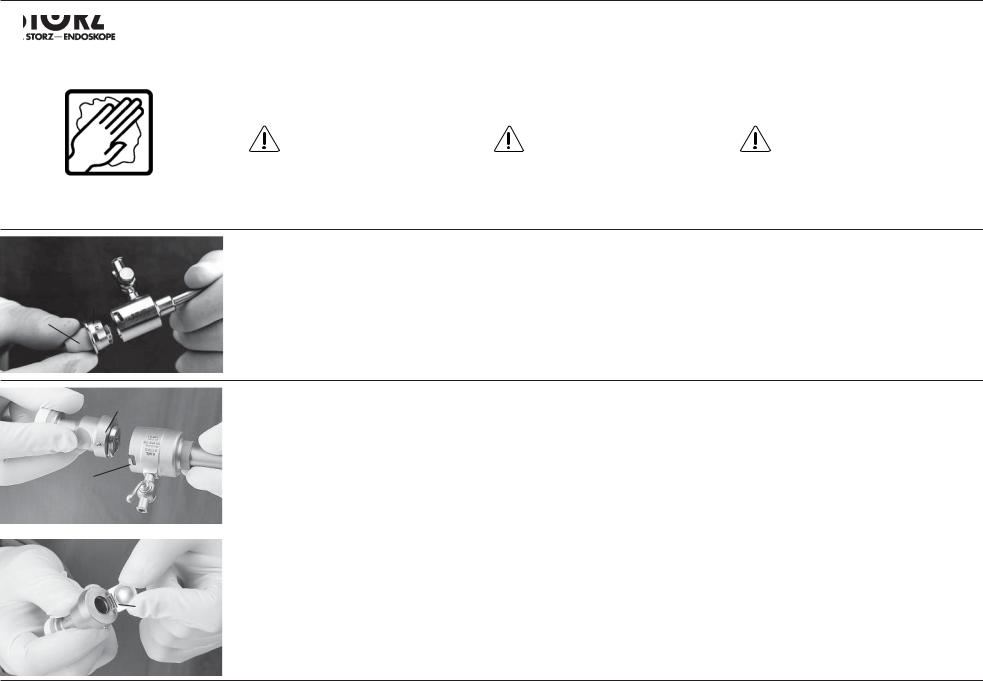
Trokare |
Trocars for |
Trocares para |
für die Laparoskopie |
laparoscopy |
laparoscopia |
|
|
|
|
|
|
Manuelle Reinigung
Die Ventilklappe bei Reinigung des Ventilkopfes offenhalten.
Vorsicht: Ventilklappe vorsichtig reinigen, da ein Dejustieren der Ventilklappe die einwandfreie Funktion beeinträchtigt.
Maschinelle Reinigung
Die Klappe durch Öffnungsstab (Art.-Nr. 26 G) oder eine entsprechende Haltevorrichtung in offener Position xieren.
Manual cleaning
Hold the valve ap open when cleaning the top of the valve.
Caution: Clean the valve ap carefully, since misalignment of the valve ap prevents smooth functioning.
Machine cleaning
Fix the ap in an open position using the opening rod (Art. no. 26 G) or a suitable holding device.
Limpieza manual
Mantenga abierta la válvula de mariposa durante la limpieza del cabezal de la válvula.
Advertencia: Limpie con sumo cuidado la mariposa de la válvula, dado que un desajuste de la misma menoscaba el funcionamiento.
Limpieza mecánica
Fije la válvula de mariposa en posición abierta mediante una varilla (nº de art. 26 G) o un dispositivo que la mantenga abierta.
Montage
Gelenk des Klappenventils gezielt ölen. Hinteres
Teil des Ventilkopfes aufschrauben.
Hinweis: Das hintere Kopfteil lässt sich mit auf-
gesetzter Dichtungskappe leichter aufschrauben.
Ventilkopf in Trokarhülse einsetzen und Bajo- nettverschluß schließen.
nettverschluß schließen.
Dichtungskappe aufsetzen. Trokardorn einführen.
Assembly
Oil the joint on the ap valve precisely. Screw on the rear part of the valve top.
Note: It is easier to screw on the rear top part if the sealing cap is in place.
Insert the top of the valve into the trocar cannula and close the bayonet mount . Put on sealing cap .
Insert the trocar tip.
Montaje
Aceite la articulación de la válvula de mariposa. Enrosque la pieza posterior del cabezal de la válvula.
Nota: La pieza posterior del cabezal se puede enroscar más fácilmente estando la caperuza de junta colocada.
Coloque el cabezal de la válvula en el casquillo del trocar y trabe el cierre de bayoneta . Coloque la caperuza de junta .
Introduzca el mandril del trocar.
|
Trokare mit automatischem |
Trocars with automatic ap valve |
Trocares con válvula automática de |
|
|
Klappenventil 6 mm bis 13 mm |
6 mm - 13 mm |
mariposa 6 mm hasta 13 mm |
|
|
Hinweis: Demontage, Reinigung und Montage |
Note: For disassembly, cleaning and assembly |
Nota: Para desmontar, limpiar y montar las llaves |
|
|
von LUER-Lock-Hähnen siehe „Anweisung für |
of LUER-lock stopcocks see ‘Instructions for |
con cierre LUER, véase la “Instrucción para llaves |
|
|
LUER-Lock Hähne“ (Seite 25). |
LUER-lock stopcocks’ (page 25). |
con cierre LUER” (pág. 25). |
|
|
Demontage |
Disassembly |
Desmontaje |
|
|
Trokardorn entfernen. |
Extraiga el mandril del trocar. |
||
|
Remove the trocar tip. |
|||
Dichtungskappe abnehmen, auf Beschädigung |
Retire la caperuza de junta, compruebe si |
|||
|
Take off the sealing cap. |
|||
|
prüfen, ggf. austauschen. |
presenta deterioros y, si es necesario, cámbiela. |
||
|
Loosen the knurled ring on the trocar cannula. |
|||
|
Bajonettverschluß an Trokarhülse lösen. |
A oje el cierre de bayoneta en el casquillo del |
||
|
Take off the top of the valve . |
|||
|
Ventilkopf abnehmen. |
|
trocar. Retire el cabezal de la válvula . |
|
|
|
|
|
|
|
Der Ventilkopf kann noch weiter zerlegt werden: |
The top of the valve may be further dismantled. |
El cabezal de la válvula se puede continuar des- |
|
|
Die innenliegende Dichtung auf Beschädigung |
Check the inside seal for damage, replace if |
montando: |
|
|
prüfen, ggf. austauschen. |
necessary. |
Compruebe si la junta interior presenta deterio- |
|
|
|
|
ros y, si es necesario, cámbiela. |
|
|
|
|
|
23
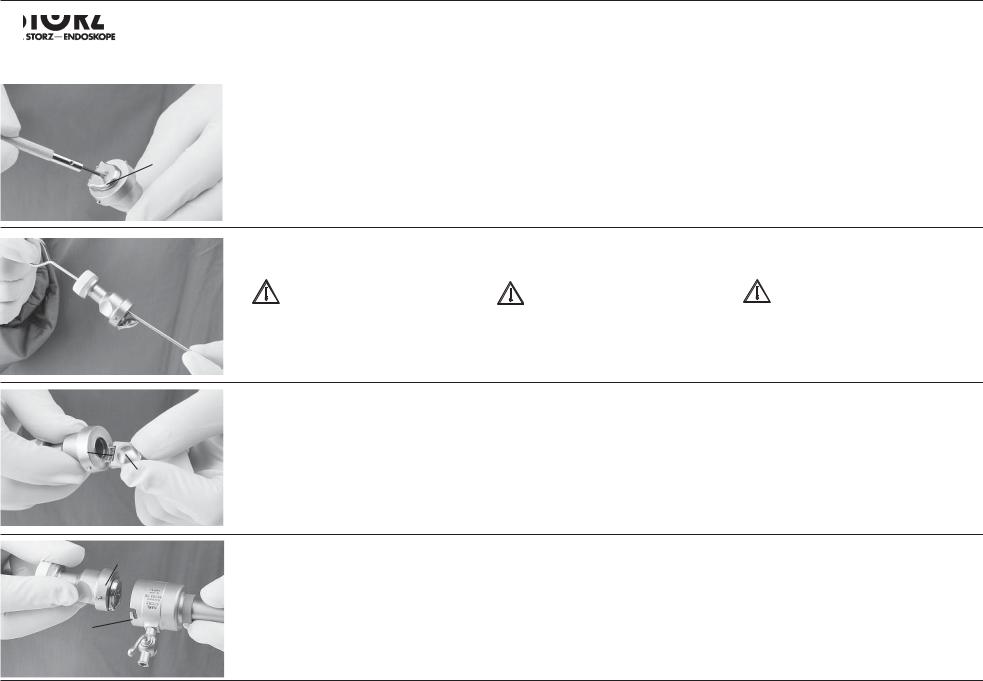
Trokare |
Trocars for |
Trocares para |
für die Laparoskopie |
laparoscopy |
laparoscopia |
|
|
|
|
|
|
Hierzu ist die Schraube über der Dichtung im Uhrzeigersinn (Linksgewinde) aufzudrehen.
To do this, turn the screw over the seal clockwise (left-handed thread).
Para ello, gire el tornillo sobre la junta en el sentido de las agujas del reloj (rosca izquierda).
Manuelle Reinigung
Die Ventilklappe bei Reinigung des Ventilkopfes offenhalten.
Vorsicht: Ventilklappe vorsichtig reinigen, da ein Dejustieren der Ventilklappe die ein-
wandfreie Funktion beeinträchtigt.
Maschinelle Reinigung
Das Klappenventil durch Öffnungsstab
(Art.-Nr. 26 G) oder eine entsprechende Haltevorrichtung in offener Position xieren.
Manual cleaning
Hold the valve ap open when cleaning the top of the valve.
Caution: Clean the valve ap carefully, since misalignment of the valve ap prevents smooth functioning.
Machine cleaning
Fix the ap valve in an open position using the opening rod (Art. no. 26 G) or a suitable holding device.
Limpieza manual
Mantenga abierta la mariposa de la válvula al efectuar la limpieza del cabezal de la válvula.
Cuidado: Limpie con sumo cuidado la mariposa de la válvula, dado que un desajuste de la misma menoscaba el funcionamiento.
Limpieza mecánica
Fije la válvula de mariposa en posición abierta mediante una varilla (nº de art.26 G) o un dispositivo que la mantenga abierta.
|
|
Montage |
|
|
Gelenk der Ventilklappe gezielt ölen. |
|
|
Falls der Ventilkopf weiter zerlegt wurde: |
|
|
Innenliegende Dichtung in die Einbuchtung |
|
|
der Klappe einlegen und mit Schraube durch |
|
Drehen entgegen dem Uhrzeigersinn xieren. |
|
|
|
|
|
|
Schraube nur leicht anziehen! |
|
Klappenventil im geschlossenen Zustand auf |
|
|
|
|
|
|
korrekten Sitz überprüfen. |
Assembly
Oil the joint on the valve ap precisely. If the top of the valve has been further dismantled:
Insert the inside seal in the ap recess and x in place by turning the screw counterclockwise. Tighten the screw only slightly!
Check the ap valve for correct seating in its closed condition.
Montaje
Aceite la articulación de la válvula de mariposa
.
Si se ha continuado desmontando el cabezal de la válvula: coloque la junta interior en la cavidad de la mariposa y fíjela con el tornillo , girando en sentido contrario al de las agujas del reloj. ¡Apriete el tornillo sólo ligeramente!
Estando la válvula de mariposa cerrada, compruebe que la misma asiente correctamente.
|
Ventilkopf in Trokarhülse einsetzen und Bajo- |
|
nettverschluß schließen. |
|
Dichtungskappe aufsetzen. |
|
Trokardorn einführen. |
Insert the top of the valve into the trocar cannula and close the bayonet mount .
Put on the sealing cap.
Insert the trocar tip.
Coloque el cabezal de la válvula en la vaina del trocar y trabe el cierre de bayoneta .
Coloque la caperuza de junta.
Introduzca el mandril del trocar.
24
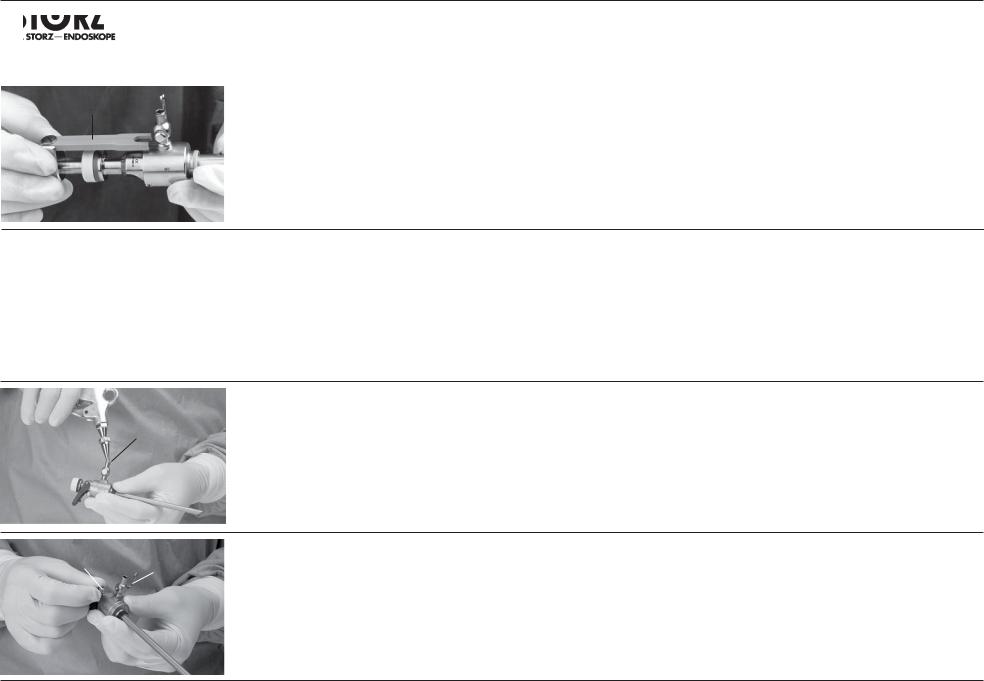
Trokare |
Trocars for |
Trocares para |
für die Laparoskopie |
laparoscopy |
laparoscopia |
|
|
|
|
|
|
Hinweis: Um die korrekte Positionierung der Trokardornspitze der Trokardorne n. REMORGI-
DA zu gewährleisten, muss die Positionierungshilfe am Insuf ationshahn einrasten.
Trokarschutzkappe aufsetzen.
Note: To ensure the correct positioning of the tip of the REMORGIDA trocar tips, the positioning aid must lock into place on the insuf ation stopcock.
Put on the trocar protective cap.
Nota: Para garantizar el correcto posicionamiento de la punta del mandril del trocar de los mandriles de trocar seg. REMORGIDA, debe encastrarse la ayuda de posicionamiento en la llave de insu-ación.
Coloque la caperuza de protección del trocar.
Anweisung für LUER-Lock Hähne
Reinigung vor der Demontage
Hinweis: Stutzen und Schaftlumen zuerst bei geöffnetem Hahn reinigen; bei Bedarf Reinigungspistole verwenden.
Instructions for LUER-lock stopcocks |
Instrucción para llaves con cierre LUER |
Cleaning before disassembly |
Limpieza antes del desmontaje |
Note: First clean the nozzle and sheath lumen |
Nota: Limpie los pitones y el lumen de la vaina |
with the stopcock open; use the cleaning gun if |
primeramente con la llave abierta; si es necesario, |
necessary. |
utilice una pistola de limpieza. |
|
Den Hahn auf Durchgang (Hahnreiber parallel |
|
zu Stutzen ) stellen und durchspülen. Darauf |
|
achten, dass solange gespült wird, bis klares |
|
Wasser am vorderen Ende austritt. |
|

Set the stopcock to Open (cock plug parallel to the nozzle ) and rinse out. Make certain that rinsing continues until clear water ows out of the front end.
Coloque la llave en la posición de paso del agua (macho de la llave en posición paralela a los pitones ) y enjuáguela. Preste atención a enjuagar hasta que por el extremo anterior salga el agua bien clara.
|
|
Demontage |
|
|
|
Federkappe am Hahn lösen, Hahnreiber |
|
|
entfernen. |
||
|
|||
|
|
Disassembly
Loosen spring cap on the stopcock, remove cock plug .
Desmontaje
Suelte la tapa del muelle de la llave, extraiga el macho de la llave .
25
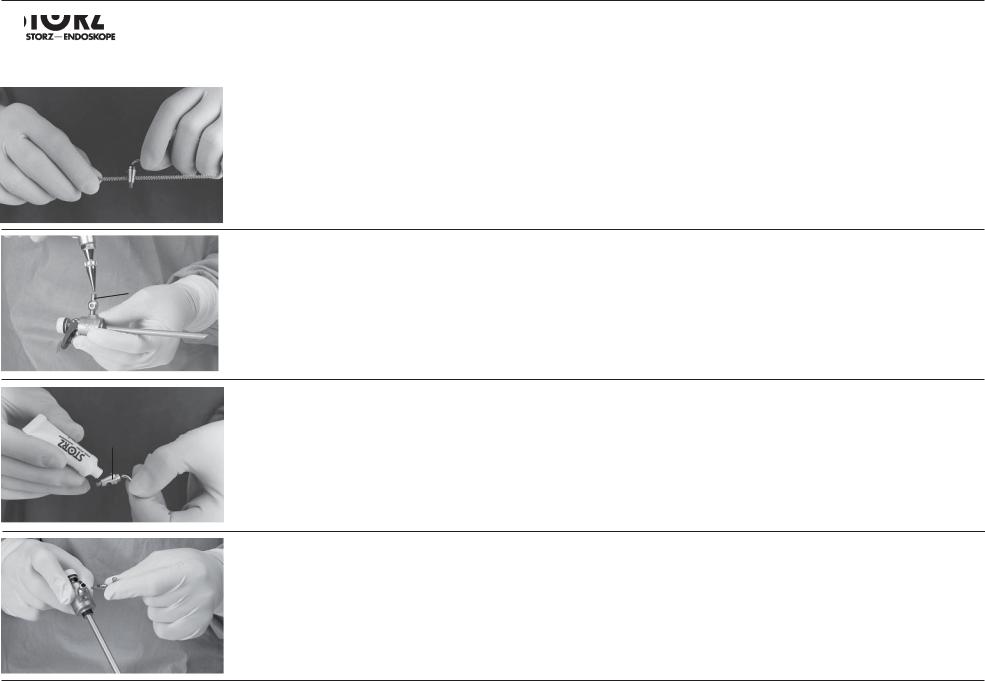
Trokare |
Trocars |
Trocares |
LUER-Lock-Hähne |
LUER lock stopcocks |
Llaves con cierre LUER |
|
|
|
|
|
|
Reinigung |
Cleaning |
Limpieza |
Hahnreiber und … |
Carefully clean the stopcock and … |
Limpie cuidadosamente el macho de la llave |
|
|
y … |
… Stutzen mit einer Bürste sorgfältig reinigen. Der Stutzen und das Schaftlumen muss bei jeder Reinigung innen gut durchspült werden, dann mit medizinisch reiner Druckluft trocknen.
… connector with a brush. The connector and the sheath lumen must be rinsed out well inside at every cleaning, and then dried with sterile compressed air.
… los pitones con un cepillo. Al efectuar cada limpieza deben enjuagarse bien los pitones y el lumen de la vaina por dentro, después séquelos con aire comprimido puro para uso médico.
Montage
Die Lauf ächen am Hahnreiber dünn einfetten (Spezialfett für Hähne; Art.-Nr. 27657).
Hinweis: Diese dünne Fettschicht dient nicht nur der Schmierung der aufeinander laufenden Metall-Metall-Ober ächen, sondern auch der Dichtigkeit der Hähne. Öl ist als Dichtmittel nicht geeignet.
Assembly
Lightly grease the contact surfaces on the stopcock (special grease for stopcocks; Art. no. 27657).
Note: This thin layer of grease not only serves to lubricate the metal-to-metal surfaces in contact with one another, but also prevents the stopcocks from leaking. Oil is not suitable as a sealant.
Montaje
Engrase ligeramente la super cie de deslizamiento de la llave (grasa especial para llaves; nº de art. 27657).
Nota: Esta delgada capa de grasa sirve no solamente para la lubricación de las super cies metálicas que rozan entre sí, sino también para la hermeticidad de la llave. El aceite no es adecuado como agente hermetizante.
Hahnreiber einsetzen und mit Federkappe - xieren. Leicht anziehen.
Funktion des Hahnreibers prüfen.
Hinweis: Hahn zur Sterilisation wieder zerlegen.
Insert the stopcock and x in place using the thumbscrew. Tighten slightly.
Test the cock plug for proper operation.
Note: Take stopcock apart again for sterilization.
Coloque el macho de la llave y fíjelo con la caperuza de muelle. Ajuste ligeramente.
Compruebe el funcionamiento del macho de la llave.
Nota: Vuelva a desmontar la llave para la esterilización.
26
